The most comprehensive online review of innos D6000 - a doubly autonomous shock-smartphone
Today, the manufacturer of the smartphone is almost impossible to seriously surprise the buyer. In the period of mass popularization of smart touch phones - from about 2007, when the iPhone appeared, and to this day - the developers managed to figure out everything: super-thin devices, gadgets with two screens, absolutely weightless devices with powerful stuffing and so on. It would seem that something new can still come up with a smartphone? Yes, such that the buyer really opened his mouth and exclaimed in surprise: “This is YES!”? All the more pleasant to realize that the Chinese innos brand really managed to create something completely new and unusual. However, let's get everything in order ...
The Chinese company JSR, owner of the brand innos, was founded in 2009. She specializes in the production of smartphones with large-capacity batteries. When creating new smartphones in innos, they rely on top-end "stuffing" from global manufacturers. In particular, innos partners include Sharp (screens), Sony and OmniVision (camera modules), Corning (Gorilla Glass glass for display protection). But the most important thing is cooperation with the US manufacturer of chipset Qualcomm. Moreover, JSR has the status of a certified partner , so fresh innos chipsets get a bit earlier than many other Chinese manufacturers. Moreover, innos is seriously refining Qualcomm solutions. So, none of the platforms of the American chip maker initially could not work with two batteries at the same time, but innos on their own solved this problem and realized not only the work from two batteries, but also the possibility of hot-swapping one of them. And they released a smartphone innos D6000, which, in fact, is the hero of this material.

JSR / innos now has more than 500 employees, and it was launched with a core of 30 engineers - people from the R & D divisions of ZTE, Huawei and Motorola. I will stress, as they say, two times: JSR is not just another contract collector, but really a large technological company with its development centers, laboratories, and its own factory. This is a company at the level of OPPO, Meizu, and so on - in short, another one of these young and daring Chinese manufacturers.
')
Dear reader, most likely, I have already come across innos products. Or at least heard of her. In 2012, the innos D9 smartphone, known in Russia as the DNS S4502 and Highscreen Boost, was released. It became the world's first Android-background with a battery capacity of over 4,000 (4,160 mAh).

innos D9
A year later, the innos D10 smartphone appeared with a 6,000 mAh record battery at that time. In Russia, it was sold as Highscreen Boost 2 (later an improved version of Boost 2 SE appeared).

innos D10
These models were created in cooperation with Russian local brands. And so JSR had to significantly save on technology and components. Well, how else, if the products DNS and Highscreen are sold in the usual retail with its “horse” (up to 30-40%) wraps? In order for the price tag to remain “tasty” after all surcharges, it was necessary, at the request of these same local partners, to look for ways to reduce the prime cost of the devices. How? Plastic is cheaper, screens and cameras are simpler, less factory testing ... And so on.
At the end of 2015, JSR entered the European and Russian markets under its own innos brand. Innos devices are sold exclusively in the brand's online store and are shipped directly from the factory to end users. In retail networks, it does not make sense to look for innos devices, but the online format of sales helps to avoid unnecessary cost increases. Innos say that it allows not to save either on technologies or on components. All that “local partners” and retail chains would “wind up” will go to price reduction, as well as to increase the level and quality of the offered devices.
Separate material in which all aspects of innos entry into the European and Russian markets are covered can be found here .
In general, today we will talk about innos D6000. This is the newest product of the brand, designed to conquer the Russian and European markets of long-lived smartphones. And he really has something to surprise. First, the innos D6000 is the first and only smartphone in the world that can work without a battery. Do not believe? See for yourself:
Secondly, it is the first and only smartphone in the world that can operate on two batteries simultaneously and with the ability to “hot-swap” one of them. Thirdly, innos D6000 has the most powerful battery on the market - 6,000 mAh, which provides up to a week of work without recharging. Fourth, it offers the best features for 17,990 rubles. However, by this time we will be back.
innos D6000 comes in a compact cardboard box of bright pumpkin (or carrot?) color. The Chinese version was sold in a box with a camel logo. The association is direct: a camel can plow the desert for months, doing without food and water thanks to a pair of its large furry humps. So innos smartphones can also work for a long time without recharging - though not months yet, but weeks. Packaging, by the way, is not cheap - it is immediately obvious that we are dealing with a product practically from the A-brand, and not from an anonymous “budget” Chinese. Inside the box there are “dividers”, the device itself is in different compartments with a protective film glued on the display ...


... as well as a power adapter, an instruction booklet and a 1-meter USB-USB Type-C cable. The cable, by the way, is bright orange: you immediately notice it in the room, and because of the color, this “string” cannot be confused with the black and white cables that smartphones usually come with. This is how the cable from innos D6000 looks like among other wires - it can be seen immediately:

This cable is inserted into the corresponding port of any of the parties, which means that the famous problem of “ USB superposition ” is missing here. In other words, we have an analogue of Lightning from the latest generation iPhone - that is, a symmetrical port and plug. It is very convenient! In my humble opinion, USB Type-C is generally the best of all that has been implemented in Android smartphones over the past three years. All these apertures and volumes of RAM seem so, um, insignificant, when you, completely tortured, at 12 at night you want to quickly put the phone on charge and flop into bed, and then it turns out that the microUSB plug, damn it, DO NOT insert. Because it had to be inserted by the other side. You insert another - and he still does not climb. I think every reader has ever been in such a situation at least once. In general, give symmetry. And do not listen to young green observers from sites about gadgets that whine that, they say, USB Type-C - it is still rare and expensive, they don’t have many cables for such a port, you have to carry with you Smartphone does not charge, and so on. That they, sorry, just show off.
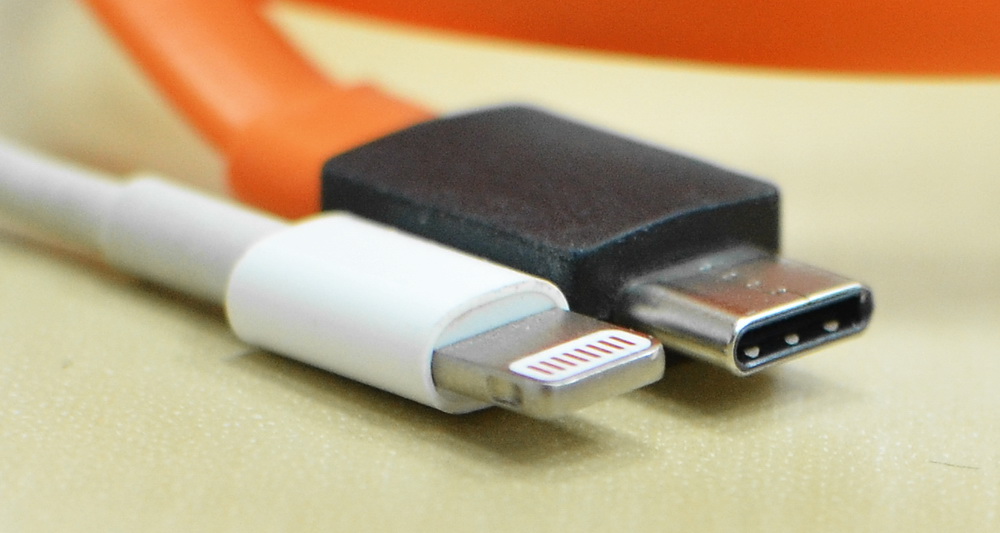
USB Type-C (right) and Lightning plugs

MicroUSB and USB Type-C: Give Symmetry!
Here, in fact, the equipment package:

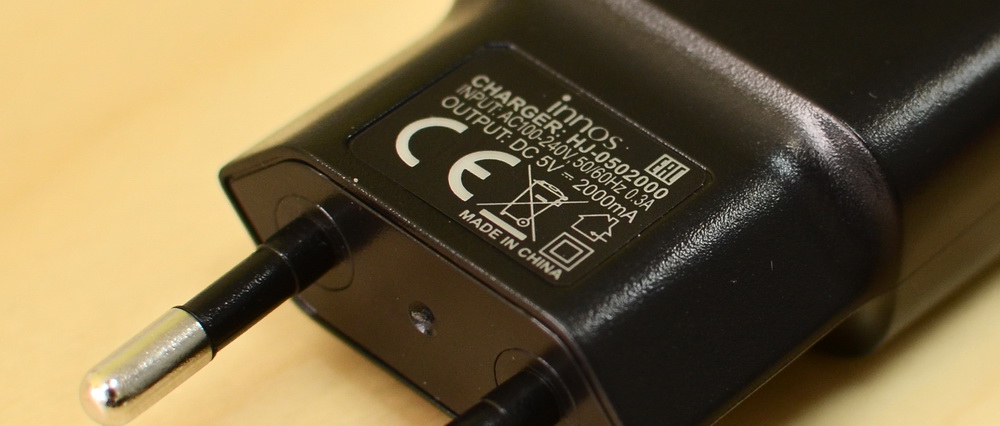


I note that the wired headset is not included. In my opinion, the approach is correct: normal “ears” would not be put anyway, but you do not want to pay for cheap ones. If you regularly listen to music from any gadget, then you probably have decent headphones with a “warm tube sound” (as is customary to write with electronics reviewers).
The case design is not the strongest side of this device. A well-rounded “bar” of coal-black color looks quite simple and inconspicuous. The device is made in the spirit of minimalism: neither the front panel nor the back side is replete with design elements. A typical "workhorse", resembling from the front whether LG Nexus 4, or LG Nexus 5.
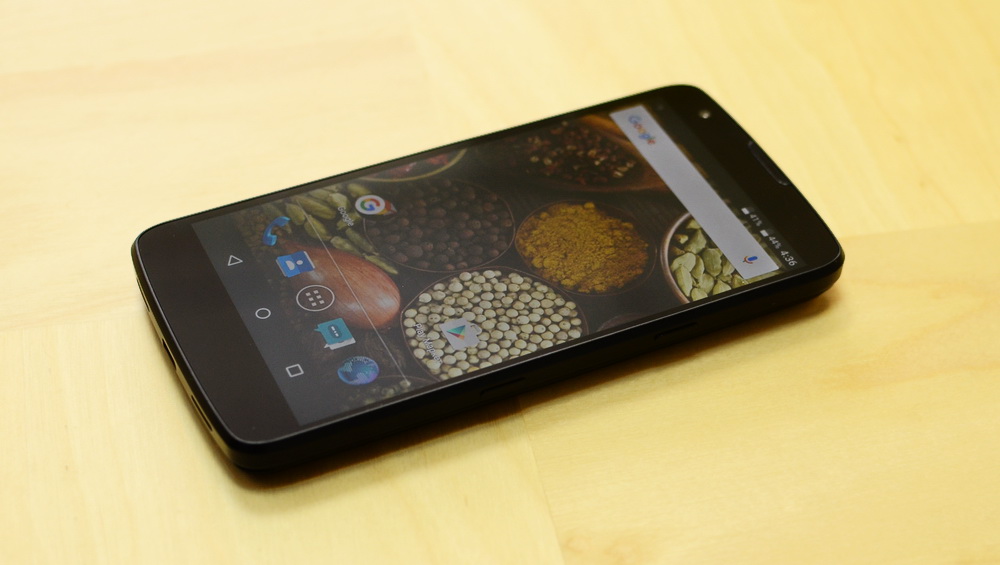
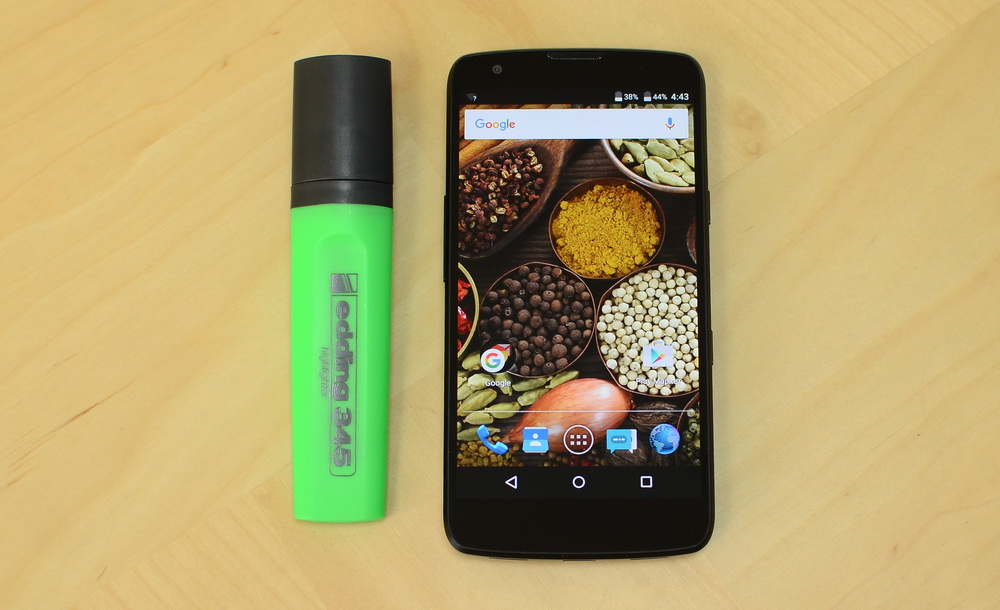
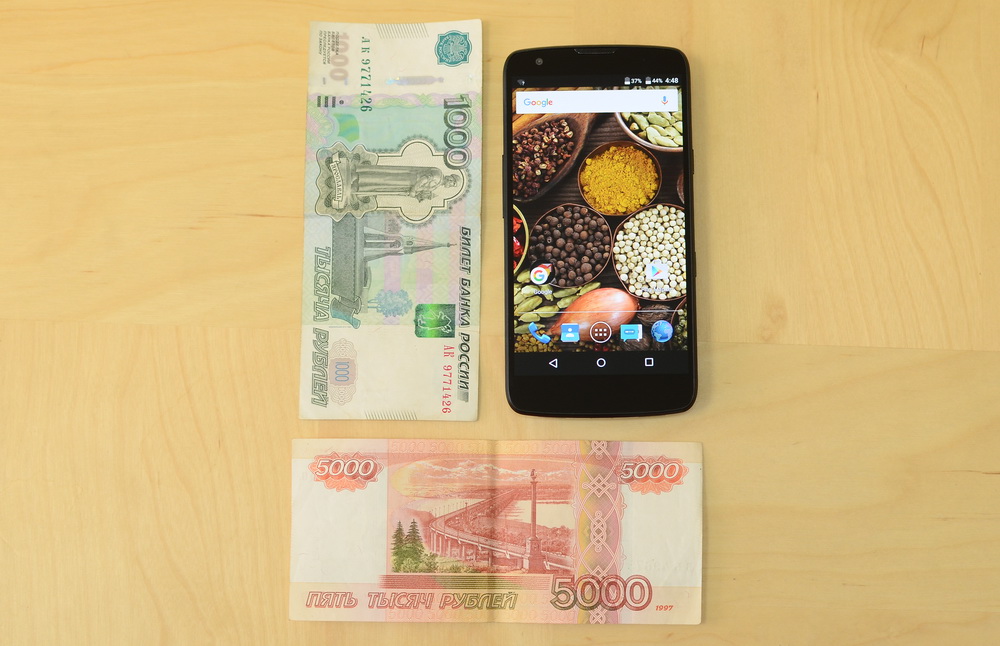

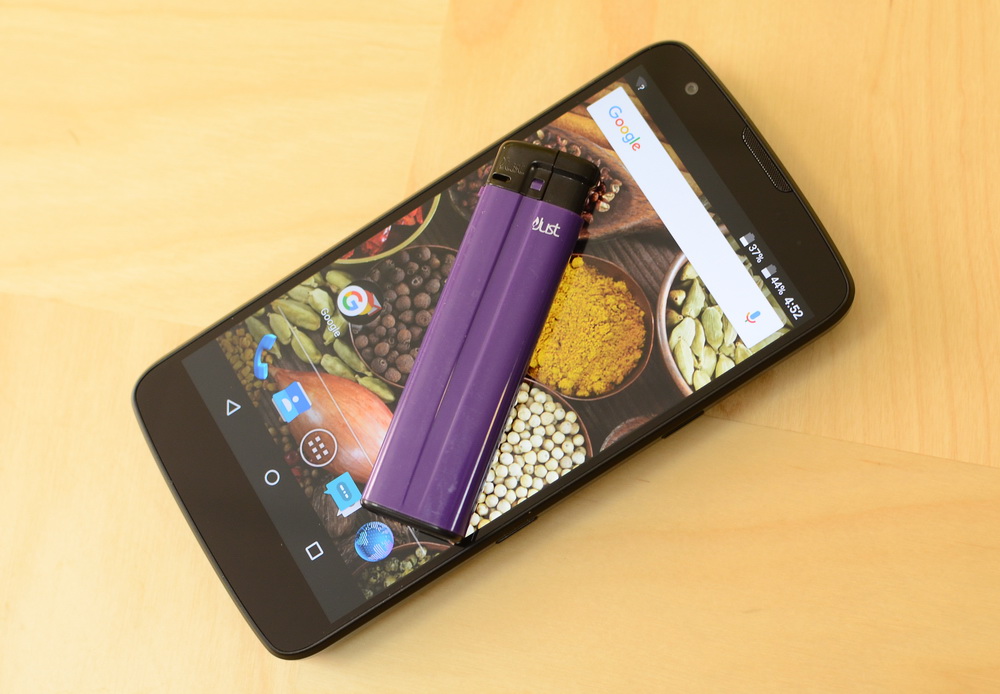

Above the display are a speaker, a front camera eye, light sensors and proximity sensors, as well as a LED indicator of various events. He blinks orange. On the one hand, it’s good that it exists at all, but I’m not able to see such a component in all smartphones. On the other - it can burn only one color. For example, on my Samsung Galaxy S5 (I understand that this is the flagship with all the consequences, and yet) the indicator lights up in different colors - for example, when it receives mail, it flashes blue, and when it receives a personal message from VKontakte, it is turquoise. So only one available color for all events is, in my opinion, some omission of designers. On the other hand, it’s better this way than without a diode at all.

At the bottom are two speakers. More precisely, not quite. There is only one speaker on the right side. On the left, just a similarly shaped hole is for symmetry. It has a “hidden” microphone. It would seem, well, let the speaker alone - do not worry. But! When you play, say, in Asphalt 8 or in Angry Birds, you block the speaker with your finger, and the sound is muffled once every five. You can, of course, flip the device and eventually achieve a position where the fingers do not overlap anything. But not everything is so simple: the same Asphalt 8 can reorient the image, but Angry Birds - no longer. And in the case of "Birds" the speaker will always overlap with a finger. We have to master the new grip, like that of coffee-drinking aristocrats - with a bulging little finger. However, users of “iPhone” do not live with this for the first year - and nothing, they do not complain, but are even satisfied.
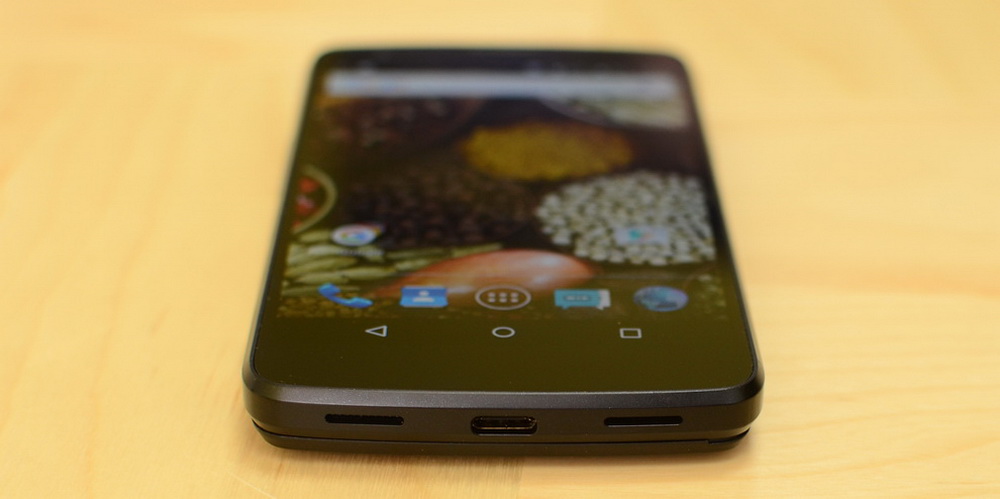
In the location of the speaker on the bottom of the case there are pluses. The sound is not muffled when the unit is on the table. The sound, by the way, is average in quality. That is, the maximum volume is high, you can not argue with that, but the device plays "flat". Until complete happiness is not enough detail and bass. However, it depends on what to compare. The same Galaxy S5 "sings" is never better.
Here, perhaps, I would say that the vibration of the innos D6000 is average in strength. You feel it in your jeans pocket without any problems, but in the pocket of your winter jacket you no longer have it. By the way, when the called subscriber picks up the phone, the device vibrates for a second - a pleasant and convenient change, you know, when you can start to “alekat”. I remember a similar feature was in the old HTC based on Windows Mobile.
Between the speaker and the second hole, imitating the speaker, is the USB Type-C port. About him, I have already spoken above, so I will not repeat. I will add only that the USB 3.1 interface is supported with a maximum theoretical speed of up to 10 Gb / s (versus 0.5 Gb / s for USB 2.0).
On the left side is a twin key ("rocker") volume control.
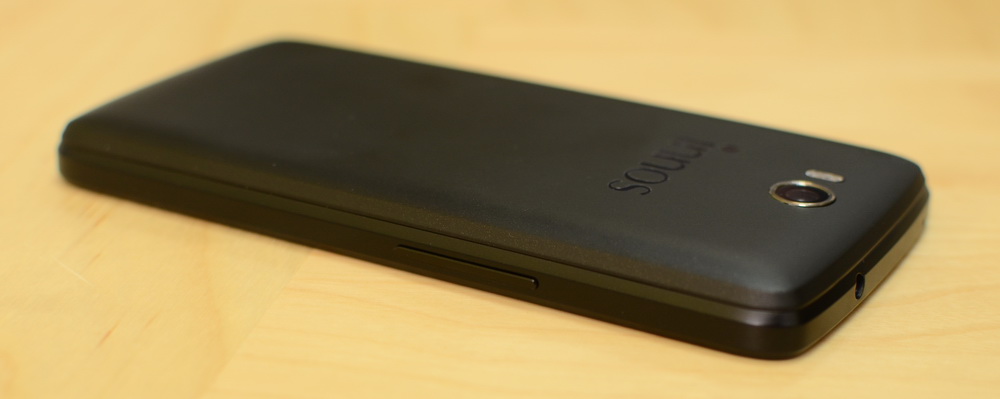
At the top of the case are a 3.5 mm headphone jack (CTIA pinout) and a second microphone. That is, there are two of them in the device, due to which a noise reduction system is implemented. Actually, the quality of speech transmission is quite decent, the interlocutors hear me well always and everywhere. I did not notice in this respect any difference with the iPhone 6, nor with the same Samsung Galaxy S5.
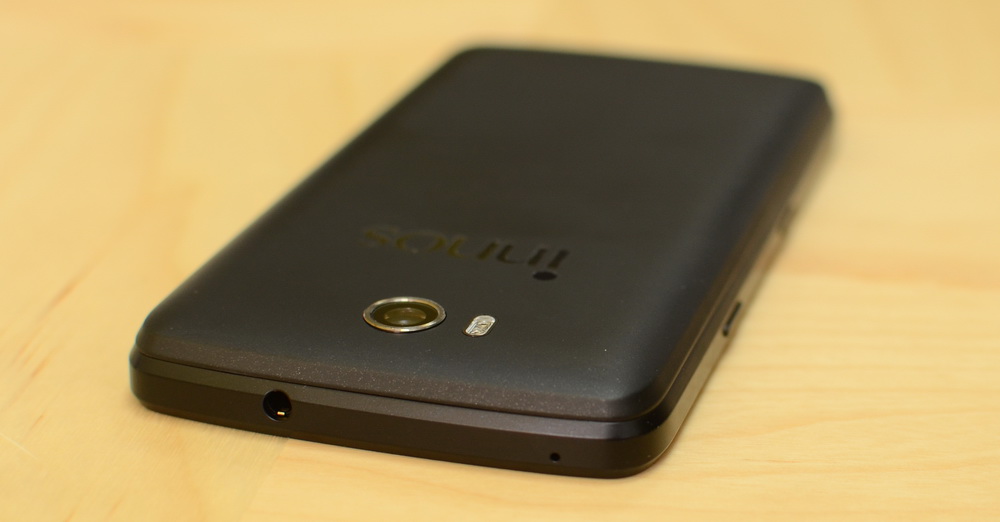
On the right side of the case there is a power button and a multifunction key.

The latter can be reprogrammed - all applications are available for assignment, both pre-installed on the smartphone and downloaded from Google Play and any other sources. For example, on this button you can hang up the function of creating a screenshot or “shutter” of the camera. Just do not forget that the level of pressing a button is only one, and this means that you will have to focus by pressing a finger on one or another area of the screen, and now you have to take a photo with a button.


All hardware keys protrude about 0.7 mm above the surface of the case and have a clear stroke. That is, under the finger they don’t hang around here and there and do not rattle, which is nice. I have seen a similar thing more than once in Highscreen smartphones - including in Boost 2. And this is just an example of savings due to an attempt to make a device sold through retail networks cheaper: they didn’t test, they didn’t observe tolerances - and you! It is pleasant to note that in innos D6000 everything was thought out much more carefully.
The back cover of the innos D6000 is removable, it is made of polycarbonate, which at first glance (and the first “probe”) looks like the good old soft-touch. But this is exactly matte plastic, that is, it will not peel off or collect scratches, no. It will collect dirt, and quite successfully. Fingerprints appear within 10 minutes from the moment you start using your smartphone. However, they are scrubbed easily - for example, with a napkin or about a shirt.
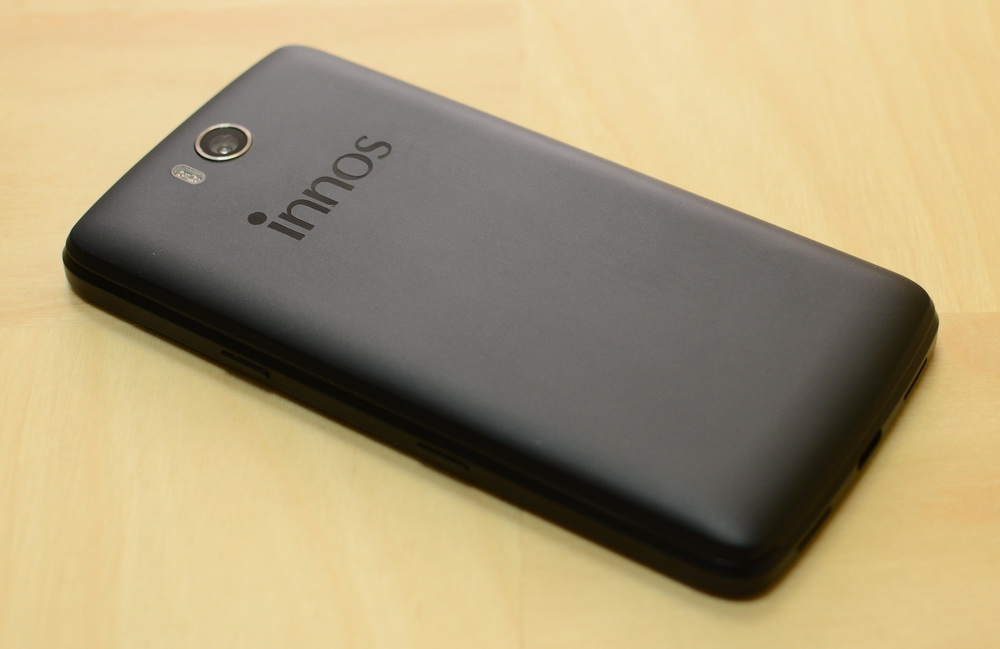
In order to remove the back panel, you need to insert a nail into the slot on the lower left corner of the device and pull up. Under the cover is a removable orange battery - in the tone of a complete box. Let me remind you once again that the device has a second, internal battery - NOT removable. It is not visible at all - it is inside the case and cannot be removed at home without a screwdriver. (You can, of course, unzip the device, but then say goodbye to the guarantee, and even to the smart itself.)

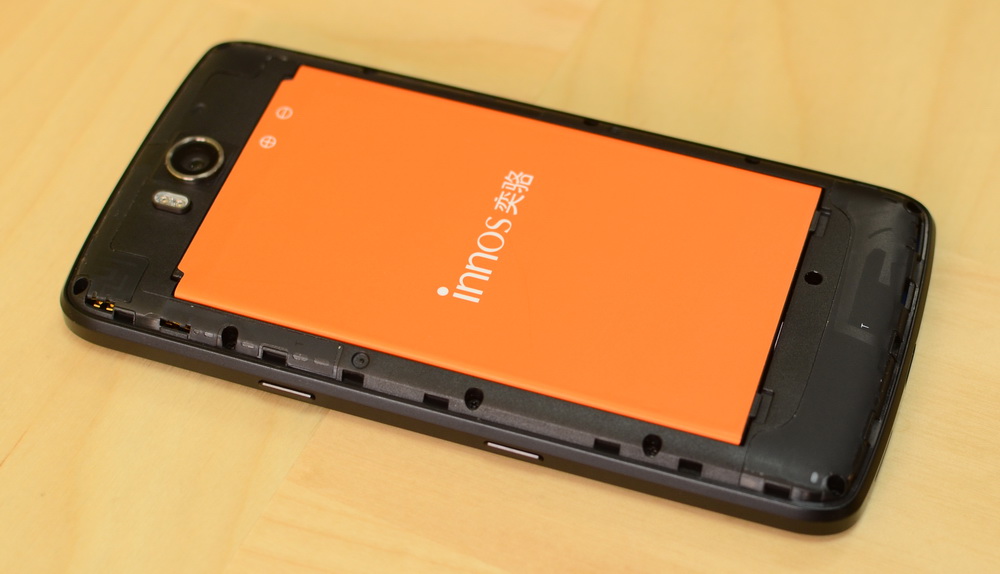

The battery closes two microSIM compartments and one for the microSD memory card. All three sockets have a design with folding metal panels that hold the cards in their places. But microSD is still just a bit more complicated: a flash drive is inserted into this socket, which for me personally was not obvious. Therefore, I was able to install a map of times from the fifth.

I consider it necessary to note that the design of the slots for SIM-cards in the innos D6000 allows using the NanoSIM cards without any problems. The same Galaxy S5 and other devices with “slot” slots for “simok” cards with the smallest format have serious problems: you can insert it, but not the fact that you can “center” correctly and then pull it out.

Innos D6000 is conveniently located in my hand, even I with my not very large paws easily reach all the keys. When the removable battery is installed, the weight of the device is approximately 190 g. Without it, the smartphone “drops” 63 grams. These numbers surprised me, I expected to get a prototype of a “brick” weighing no less than 300 g. Another plus in the device's box! Although, I must honestly admit, the innos D6000 turned out to be a purely masculine machine - for the ladies, it is clearly big and thick. For the weaker half of humanity there is a mass of super-thin super-lightweight models with small batteries, which, by virtue of this particular feature, are not suitable for everyone. So ... I have to choose: either the device is elegant, but it asks for a charge once a day, or a mobile phone is well-fed, like innos D6000, but it works for a really long time. I - for the second option. You take the D6000 in your hand - and immediately understand: the thing! No here here these ostentatious graces and other ryushechek. Only hardcore.
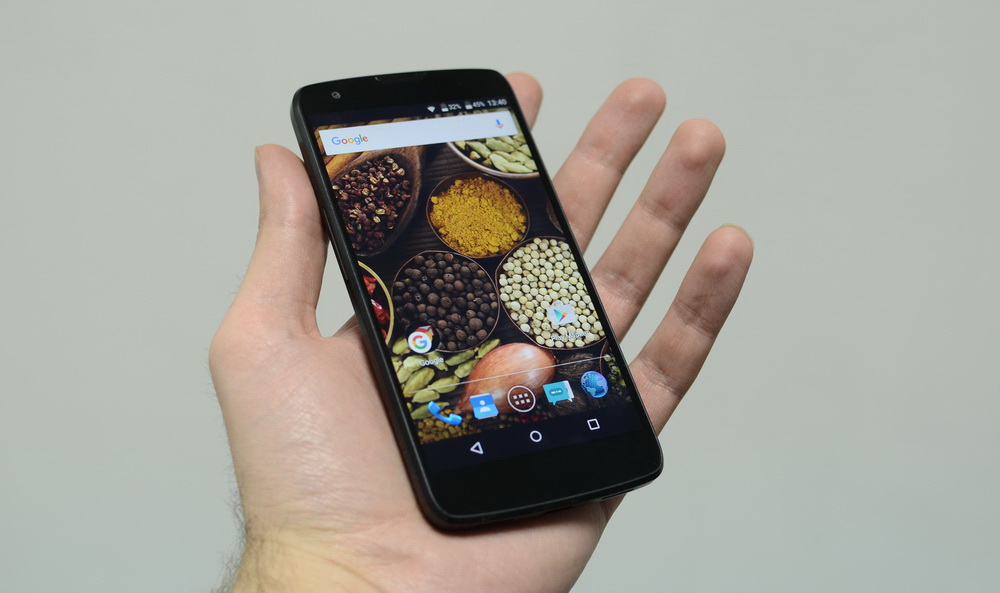
innos D6000 in male hand
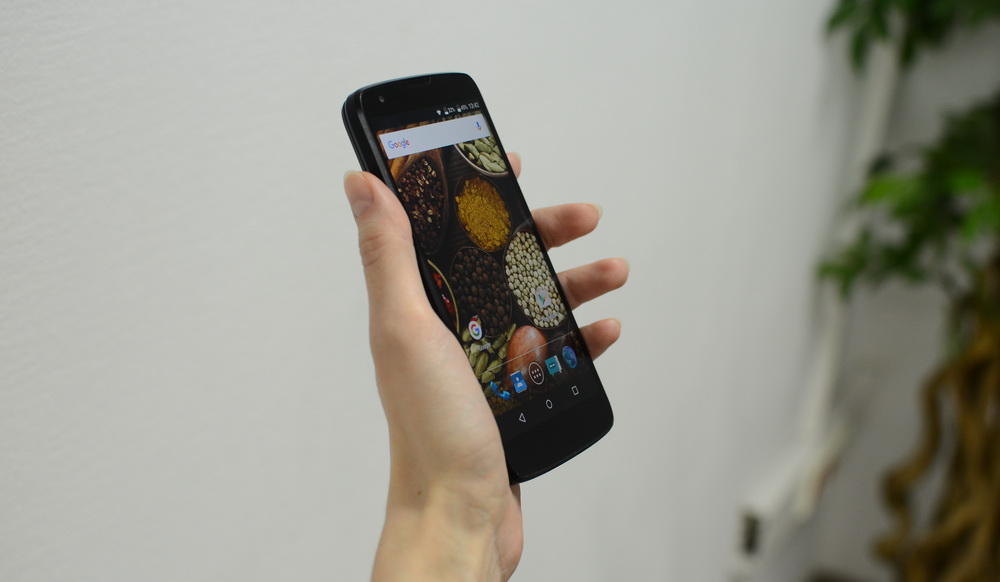
innos D6000 in a female hand
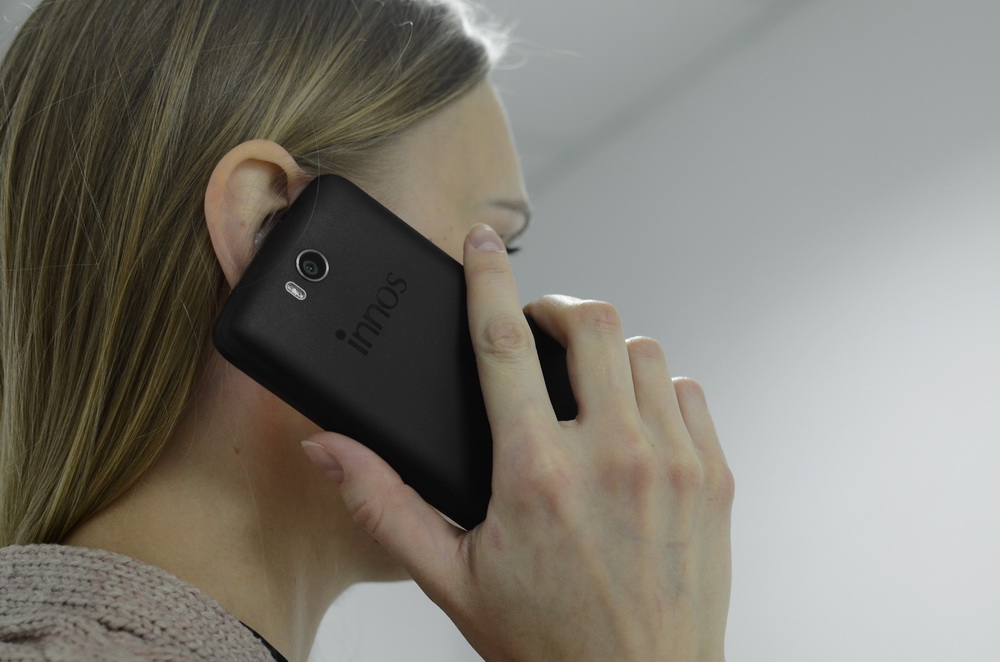
The girl speaks on innos D6000
There are no complaints about the build quality: there are no excessively wide gaps between the panels and the play of the body elements. That's just without a removable battery, the back cover bends slightly when pressed. This was to be expected: if the battery is not installed, then empty space is formed under the panel. An investigative experiment showed that this empty space can be used as a cache - a bank card or a small stack of folded bills are placed. It is very convenient if you don’t like it when there are a lot of foreign objects hanging in your pockets, or you don’t want to lose all valuables at once.


The display is built on an IPS-matrix from the company JDI (Japan) and does not have an air gap between this matrix and tempered Corning Gorilla Glass 3. That is, the device implements OGS (One Glass Solution) technology. The colors are bright, the picture on the screen is vivid and clear, although there is a slight departure in cold tones. There are no settings for color rendition, as in separate smartphones on MediaTek chipsets (these tools are called MiraVision), in innos D6000. However, it was not very desirable: these very “cold tones” will be noticed only by very picky aesthetes. What the screen can be praised for is the normal black color (and not dark gray, like inexpensive IPS-matrices) and wide viewing angles - when the smartphone is rejected, the picture almost does not fade.





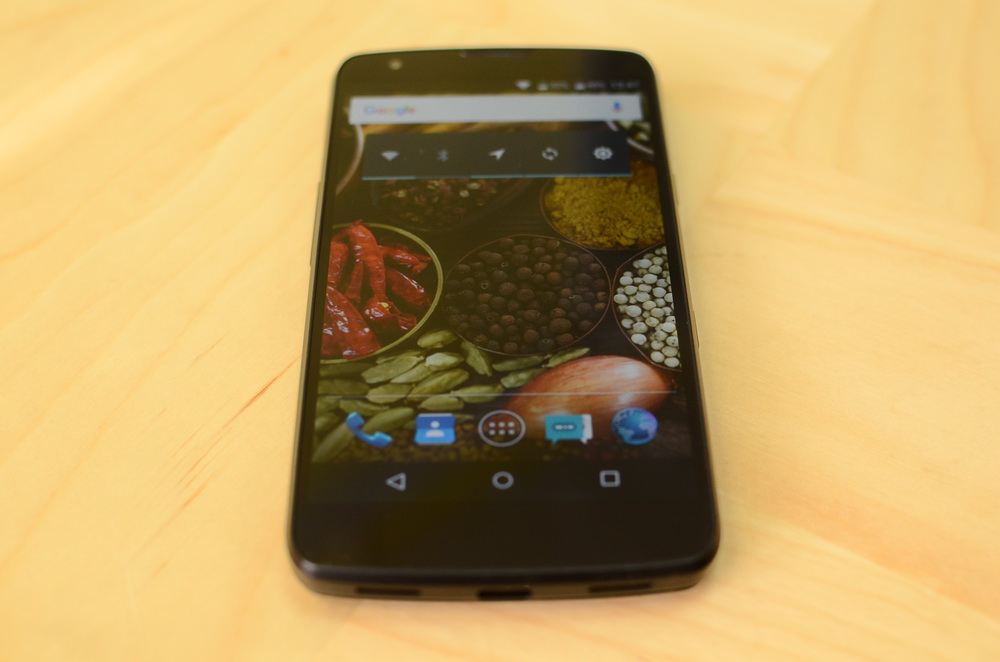
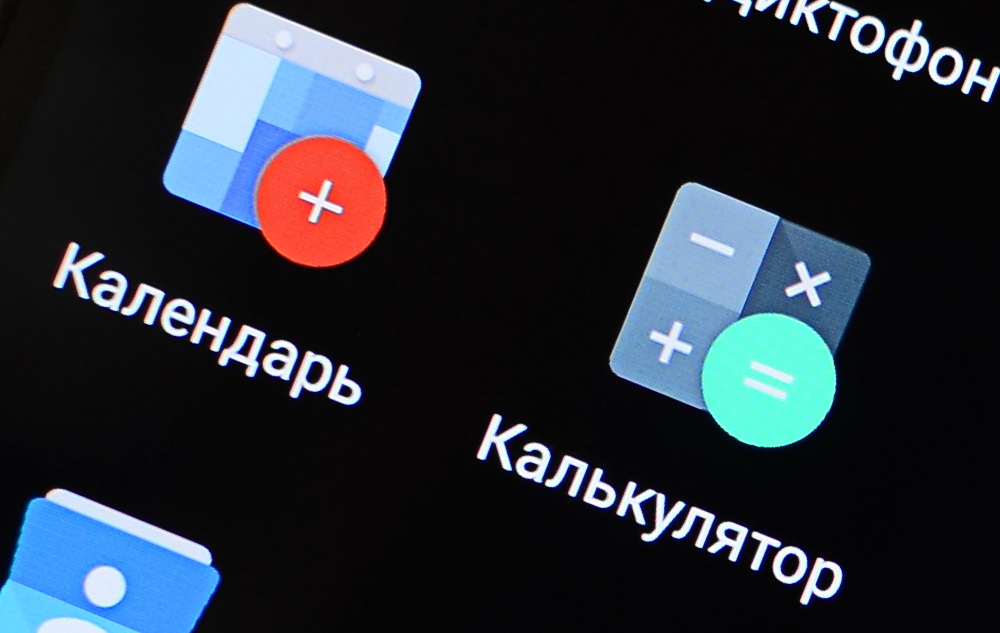
Macro display
The diagonal of the screen is nonstandard: not 5 inches, not 5.5, but 5.2 - like that of the Motorola Droid Turbo. I must say that this is a great option in order to make the smartphone more convenient compared to typical 5-inch devices, but at the same time and not to turn it into a "spade" with all the consequences. The resolution is 1920 x 1080 pixels, that is, Full HD. For such a diagonal is more than enough. In general, I do not really understand why putting QHD-matrixes into 5-inch smartphones: the difference from Full HD is not visible, and the load on the battery and iron is significantly increased.
By the way, the matrix in innos D6000 is “thoroughbred” - it was released by the Japanese company JDI, an alliance founded by Sony, Hitachi and Toshiba. As you understand, on the high-quality matrices, these comrades have not eaten one doggy (although the Japanese, not the Koreans). JDI delivers screens, for example, for selected top-end smartphones Xiaomi and Sony, as well as - that's your time! - YotaPhone first generation.
Oleophobic coating and anti-glare filter are present - and these are signs of an expensive quality product. In the budget Chinese smartphones and models of local Russian brands of these options, as a rule, no. Touchscreen, of course, capacitive (when was the last time you saw a resistive touchscreen on your smartphone?), Up to 5 simultaneous touches are supported. I would like, of course, 10, even if I don’t quite understand - why. As they say, Schaub was.

The display is covered with a factory transparent film. I can’t call it very high quality: after a week of operation, it was covered with a mass of scratches. They do not seem to affect the quality of the picture, but the apparatus because of these potholes looks untidy at the sun. In general, I removed the film, and went for another week without it. On the screen itself, scratches did not appear - yet Gorilla Glass 3! On the other hand, there is an alternative point of view about the film: a colleague walks with innos D6000 exactly the same amount as me and she has only a couple of small scratches. This, apparently, depends on the degree of personal accuracy ...
Light and proximity sensors work correctly. The first one allows you to automatically adjust the screen brightness depending on how well the space around the user is lit, and the second one “extinguishes” the screen when you hold the phone to your ear during a call.
innos D6000 is based on the Qualcomm Snapdragon 615 chipset (MSM8939), which provides eight 64-bit ARM Cortex-A53 cores (28 nm LP), divided into two four-core clusters. Moreover, only one cluster can operate at the full frequency (1.5 GHz), the second operates at a reduced frequency (1.1 GHz). This is one of the options for implementing the ARM big.LITTLE architecture. Of course, all the cores can work simultaneously with frequency auto-tuning, depending on the complexity and type of the problem being solved. Snapdragon 615 is definitely a middle-class solution, and you should not expect phenomenal performance from it.


However, I personally (personally I!) Have long been convinced that productivity is not a tangible thing, and parrots influence the user's brain and ego more than the actual speed of the smartphone. Here innos D6000 does not allow any slowdowns in Android, and applications and games do not freeze when working and perfectly coexist in LPDDR3 RAM, here as much as 3 GB (against 2 of most competitors). At the same time, 3D-games allow to set the maximum graphics settings - if, of course, such an option is provided in the title. As they say - what am I doing wrong? How to feel the pain of using the "middle class solution"? I do not know.

Choosing the highest quality graphics in Asphalt 8
In general, I state: today, Snapdragon 615 is enough for almost all “smartphone” tasks (except maybe 4K video recordings). At the same time, the Qualcomm solution is a priori more stable than MediaTek chipsets. (It was rumored that innos intends to release a version of the D6000 with the MediaTek chipset, but these are just rumors that have no relation to reality!) So ... It's not that bad. And yes, thanks to the developers for not using Snapdragon 810. Firstly, it would significantly raise the price of the smartphone, and secondly, this chipset is known for its overheating problems . So it’s better to have a stable and time-tested tit Snapdragon 615 in your hands than a buggy and unstable crane Snapdragon 810 in the sky. Here, I note that there is also a Snapdragon 616 (MSM8939v2): it differs from the model with the 615 index only by a slightly raised frequency of the “weak” cluster, from 1.1 to 1.2 GHz. So there is no horror in the fact that Snapdragon 615 is used in innos D6000, I do not see. By the way, it is also used, for example, in Samsung Galaxy A7, Lenovo Vibe P1, Xiaomi Mi4i, HTC Desire 810, Motorola Moto X Play, Asus Zenfone Selfie, Sony Xperia M4 Aqua, etc.
For graphics processing in the Snapdragon 615 meets the accelerator Adreno 405 with a frequency of up to 550 MHz. Support is provided for the OpenGL ES 3.1 software interface and the H.265 video codec.
On the situation with games. I suggest several videos that demonstrate the gameplay and the absence of brakes. Here, for example, Asphalt 8:

Modern Combat 5:

Mortal Kombat X:

WoT Blitz:

Dead Trigger 2:

During the game, the smartphone becomes warm, it's true, but it was unpleasant to hold it in your hands to heat it up so much that the D6000 did not work. On the contrary, the heated innos D6000 feels very pleasant to the touch - as if you caress a cat :)
And, of course, the results in benchmarks. 34 thousand points in AnTuTu is a good average level, which is enough for the vast majority of situations. No, of course, I would also be pleased if my smartphone scored 100 with the hook of thousands. If you are pleased, let's save it together on the Galaxy S7. It will be necessary only 50 thousand rubles. innos D6000, I remind you, it costs 18 thousand.

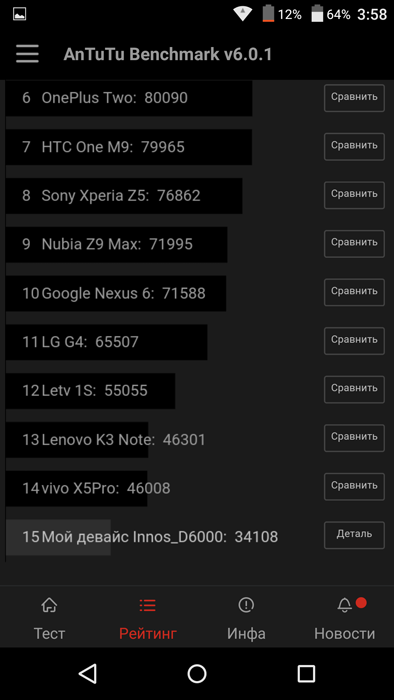
Results in AnTuTu
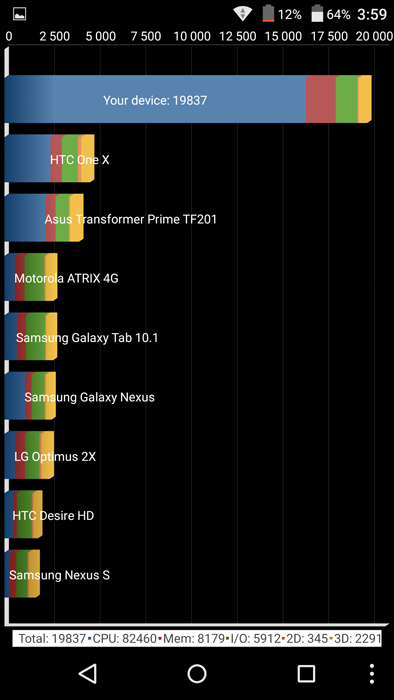

Quadrant and GeekBench 3 Results



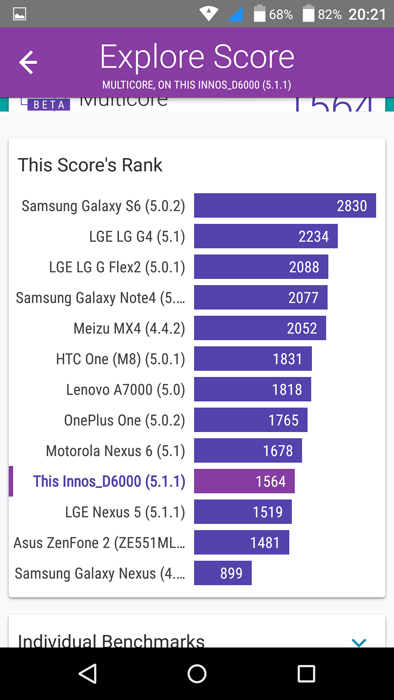
Results in Vellamo

Epic Citadel Results

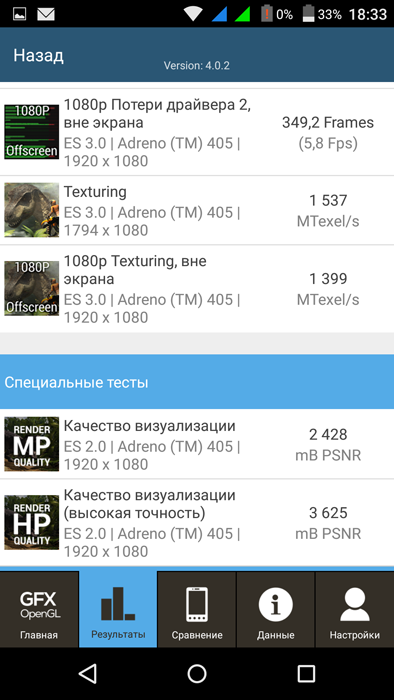
Results in GFXBench GL

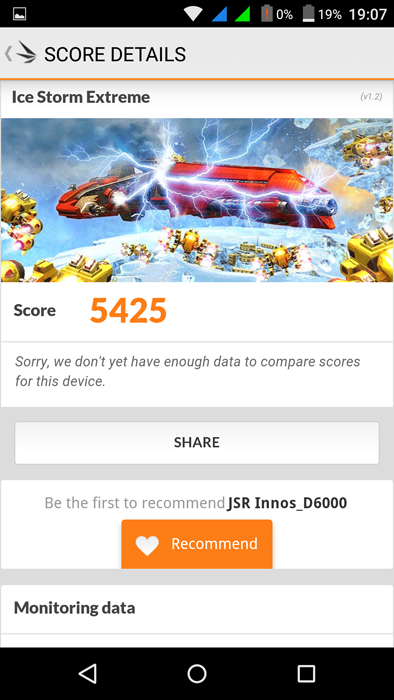

3DMark results
Video playback innos D6000 copes well - with the help of MX Player, you can watch including files in 4K resolution. With Full HD-rollers in general, no problems.
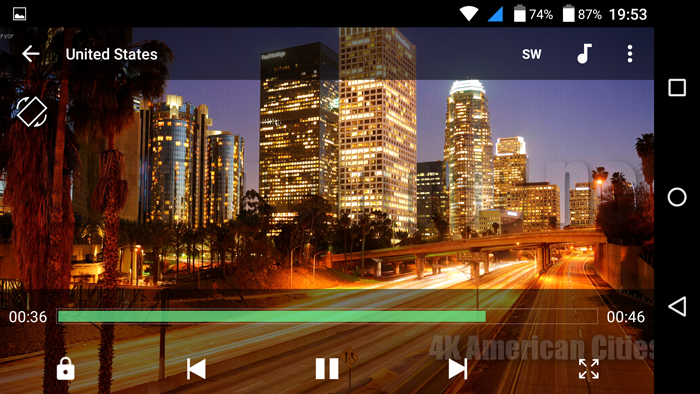
View 4K video on innos D6000
The Snapdragon 615 includes Bluetooth 4.0 LE, 802.11n (2.4 GHz) Wi-Fi with Miracast, GPS / GLONASS / Beidou, 2G / 3G / 4G. Slots for SIM-cards in innos D6000, as already mentioned, are two. I can’t say anything special about Wi-Fi and Bluetooth - everything is working fine. One can only grumble that there is no support for the 5 GHz band - it would not hurt in the megalopolis. Wi-Fi Direct support — such a file-sharing interface — is present. As an access point innos D6000 can work. I regularly use this function when electricity is cut down.


Wi-Fi Direct Setup


Setting up a portable access point
With cellular communication, everything is in order, above I have already said that there are no complaints about the quality of voice transmission, but here I will add that the smartphone catches the network is absolutely normal. In general, this is typical of almost all devices on Qualcomm chipsets, and innos D6000 is no exception.
To work with SIM-cards, a standard manager from Android is provided.


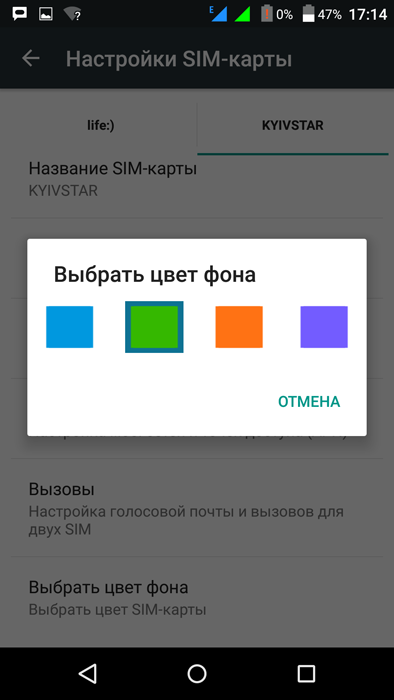

In 3G and 4G / LTE networks, only one SIM card can work, the second can only be connected to a 2G network at this time. The radio module is one, so that at the time of the call from one card, the second one “falls off”. This is a normal situation, as it is now in all "dvuhsimochnyh" smartphones. Here I’ll add that in the case of LTE, all the “bands” that are relevant for Russia are supported: 1, 3, 7, 20, 38 and 40.

An important point. In the firmware for the Chinese versions of innos D6000, the ability to work in CDMA networks is also implemented, and the device supports this technology at the hardware level. In the version of the smartphone for Russia and Europe (about its features - in a separate subsection, see below), this option is deactivated, since CDMA networks are not common either in our country or in European countries.
Speaking of navigation, I note again that the models on Qualcomm chipsets usually have no problems with it. So innos D6000 they are not. The smartphone catches GPS (USA), GLONASS (Russia) and Beidou (China) signals and does not lose them in the process of navigation. A cold start without A-GPS takes about two minutes, during this time there are a dozen satellites. With A-GPS, everything happens even faster. The electronic compass in the smartphone is provided, I emphasize this, since this option is not available in all budget models.


By the way, navigation was tested using Here Maps. All a bunch, nothing to complain about.

NFC support in the innos D6000 is missing. This, in my opinion, a minus. I myself never in my life felt the need for this technology, but ... It would be better if the device supported it, because other smartphones support, but this one doesn’t - what kind of discrimination? By the way, many Chinese manufacturers for some reason prefer not to implement NFC in their models. For example, Xiaomi ignored this option for a very long time - NFC support appeared only in Mi5.
The device has 32 GB of internal memory, of which about 26 are available. Usually, smartphones with similar price tags have 16 GB drives, so the innos D6000 can be commended.
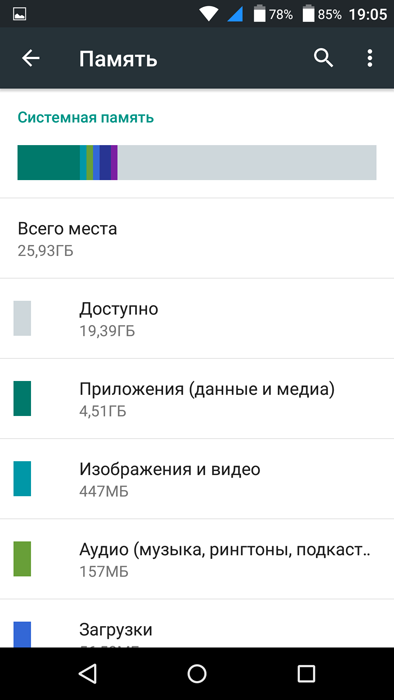
Officially supported microSD cards up to 32 GB. It is necessary to clarify that in order to realize support for larger flash drives, you need to buy a license from Microsoft, and then also “unfasten” a few cents from each sold copy of the smartphone. Indeed, the device refused to work with a 64 GB card.That is, he reported that the flash drive is inserted and requires cleaning, as it has problems with the file system. Pressed "clear" - and nothing happened. Meanwhile, the device “sorted out” with a 32 GB card without any problems.
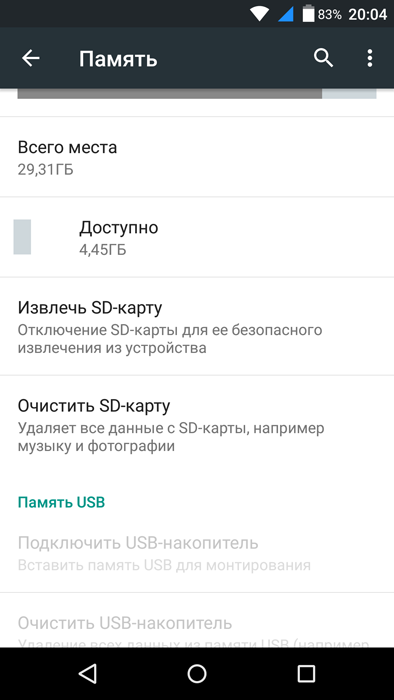
OTG smartphone is supported, but do not forget that the innos D6000 has a USB Type-C port. So standard “MicroUSB - USB” adapters will not work, you need to order a special version of “USB Type-C - USB”. Well, or buy a USB flash drive with a USB Type-C plug. Cheerful Chinese have riveted the car and a small cart of models of such drives, when Apple announced its 12-inch MacBook with a single port - USB Type-C.
Here again I remind you that innos D6000 supports USB 3.1 interface with a maximum theoretical data transfer rate of up to 10 Gbit / s (versus 0.5 Gbit / s for USB 2.0).
Options for connecting to a PC are as follows:
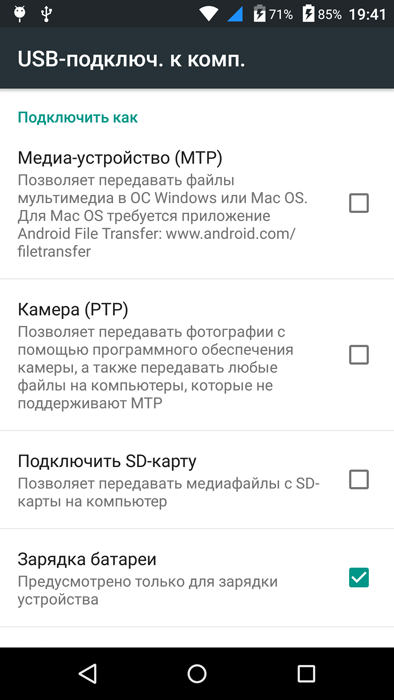
We turn on the innos D6000, knowing that it is running Android 5.1.1 Lollipop, and ... We see something similar to Android 4.4 KitKat, 4.2 Jelly Bean, and other early versions of the OS. What, as they say, funny? The fact that smartphone developers can use Android 5.0 / 5.1 Lollipop both in a kind of “bare” form (both in innos D6000) and with the Google Start launcher. Usually it is the second option that is activated, but for some reason innos were inclined to the first. Admire:


I remember, there was such a case. When LG Nexus 5 with Android 4.4 KitKat was announced, I looked at the pictures on the Internet and saw that the OS had a noticeably changed interface. Immediately useful to update your ASUS Nexus 7 (2012).Updated from 4.3 Jelly Bean to 4.4 KitKat - and suddenly realized that the interface had not changed at all. Later it turned out that the Google Experience Launcher launcher was included in the Nexus 5 firmware (and only Nexus 5), which was changed by this very interface. Later, this shell became available on Google Play for ASUS Nexus 7 (2012). And then she changed her name and turned into Google Start. And it can be easily installed on innos D6000, having received all the Material Design elements:
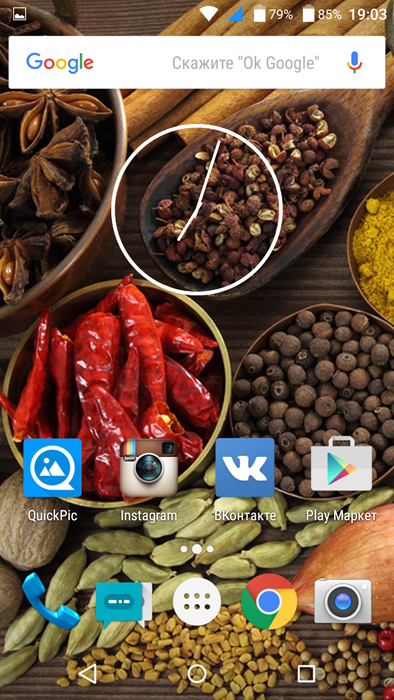

By the way, I draw your attention to the fact that there are no hardware control keys in the innos D6000, three standard buttons are virtual and are located at the bottom of the screen. For them, the possibility of reassigning / adding features. In addition, additional functions can also be assigned to the hardware power and volume keys - call termination and screen activation (that is, “waking up” the device), respectively.


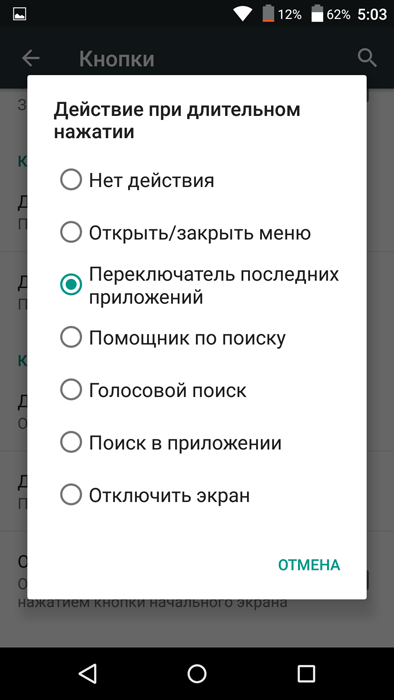
In the software there are a few interesting additions from the developers. First, the function of recording conversations. It is clear that for this you can install an application from Google Play on any smart, but not the fact that it will work. And here the recording option is built into the firmware and works with a bang. The only pity is that the smartphone cannot automatically record all conversations - every time you have to activate this function during an incoming (or outgoing) call.


There is a built-in "black list". With it, the innos D6000 can "repel" both calls and messages from unwanted subscribers.

In the list of recent applications there are two additional buttons: the left one allows you to go to the task manager, and the second one - to remove all the cards with one tap. Very comfortably!


Blur effect. Can be used for the following parts of the interface:

On the left - with a blur effect, on the right - without it (by default it is turned off):




The battery charge can be displayed as a percentage in the status line:

Not without support profiles:

In the shutdown menu there are options for rebooting and changing the profile:

Otherwise, everything is more or less standard - pure Android without "left" impurities. There are almost no additional applications - except for the file manager and download label for Qualcomm Battery Guru, which in theory saves battery power.
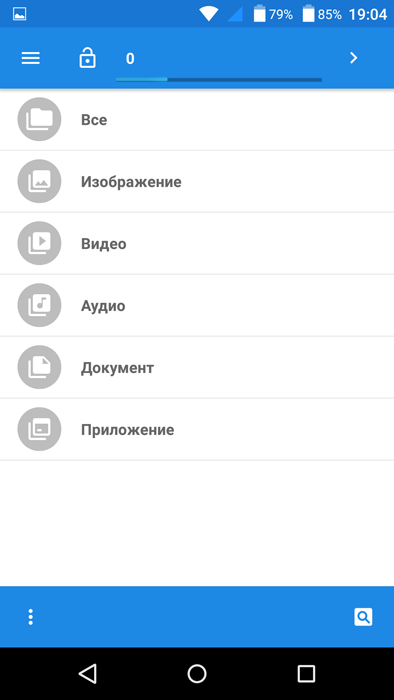
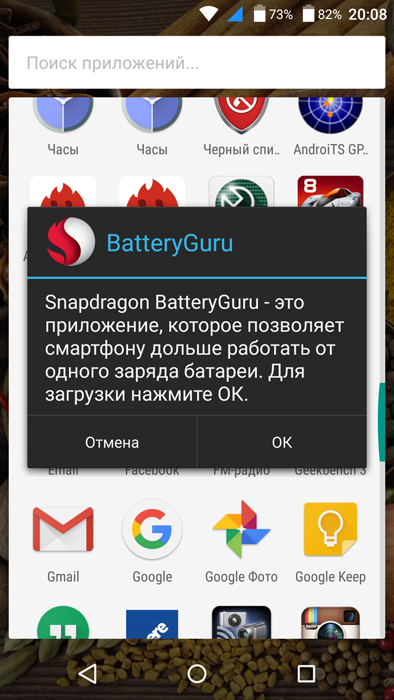
Below are a few more screenshots, if someone suddenly forgot what the Android Lollipop looks like.

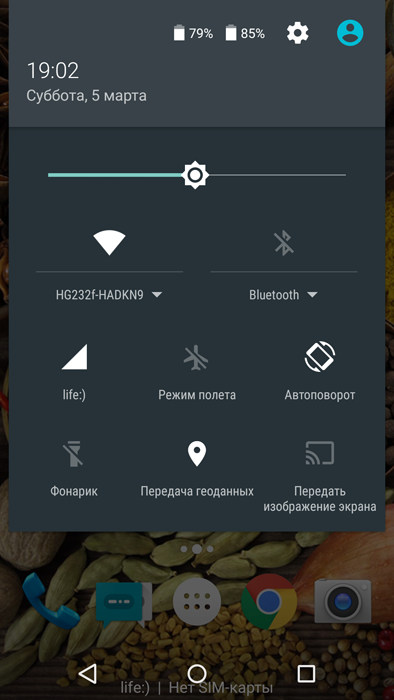




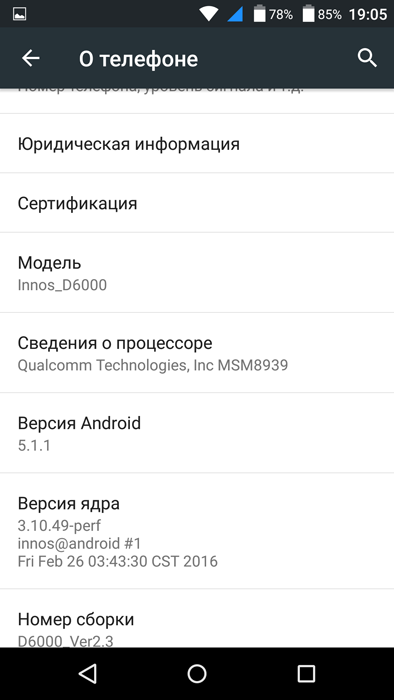

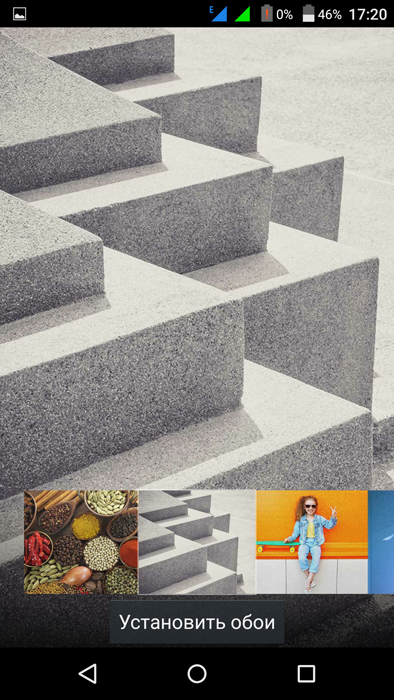
About firmware updates (of course, innos D6000 supports OTA - updates over the air). As you know, drivers providing support for the next version of Android by one or another chipset are prepared by the (chipset) manufacturer. In this case, it is Qualcomm. And Qualcomm says that Android 6.0 Marshmallow for Snapdragon 615 will become a reality at the end of the first quarter of 2016. Then the corresponding firmware for innos D6000 will be released. Also for the hero of this material are preparing Cyanogen firmware, but when they will be released is not yet clear.

I will say right away: I have never been a music lover and certainly not an audiophile. And I really do not have expensive headphones in my household. So, complete from Sony Walkman NWZ-S763. As a result of listening to several tracks in different genres, I can say that the above mentioned player plays slightly better than innos D6000. However, in my particular case, the latter is quite able to replace the stationary music player. Yes, in some places the sound feels a bit flat, there is not enough bass, but it seems to me that it will suit 99% of users. The remaining percentage - those are the same audiophiles (well, or those who are trying to seem to them in the discussions on the forums).
Music player innos D6000 standard for Android. There is a set of improvers from Qualcomm, they change the sound - I'm not sure that it is for the better, it just becomes a little different.

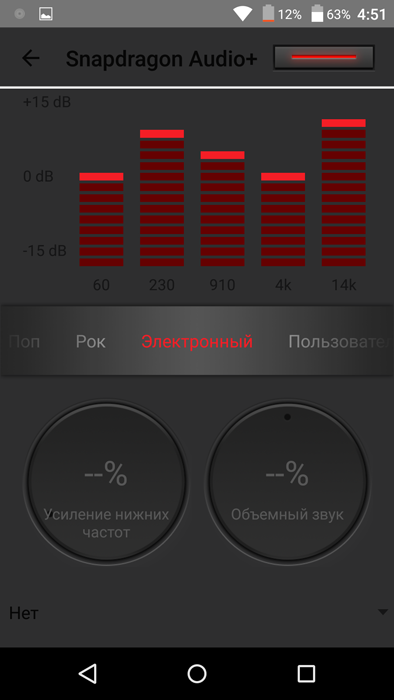
The application for listening to FM radio is standard, the same is found in most smartphones with this feature. It is possible to record the broadcast. As in 99% of modern smarts, the radio in innos D6000 works only with connected headphones - they act as an antenna. In this case, the sound, of course, can go both in the ears and in the speaker.
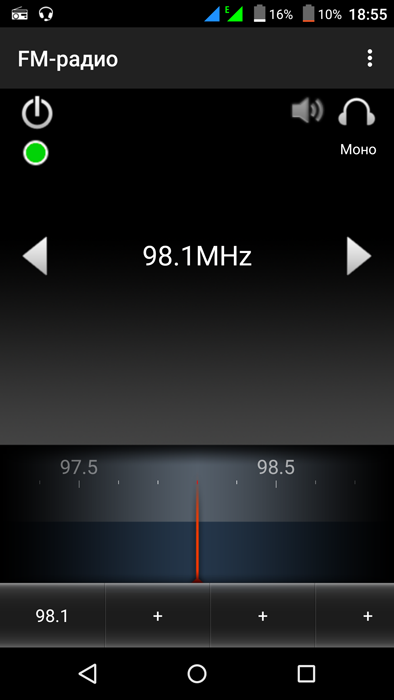
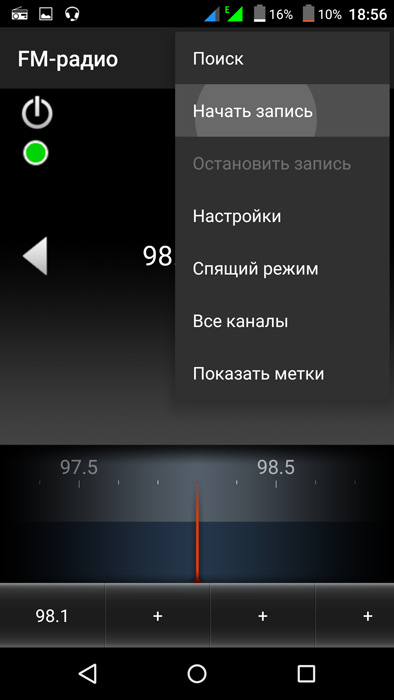
Innos D6000 has two cameras, the main one with 16 megapixels (BSI II module, aperture f / 2.2) and the front one with 5 (BSI + module, also f / 2.2). Both are made by the American company OmniVision. There are no fashionable features - like a phase or laser autofocus, an optical stabilization system, an incredible aperture, and so on - in our hero. LED flash, albeit dual, but monochrome. Video is recorded in Full HD 1080p resolution at up to 30 frames per second - Snapdragon 615 does not support recording clips in 4K.
I emphasize that 16 megapixels in our time - the time of social networks - is much better than the standard for smartphones of this class 13. It’s clear that the resolution on photo quality never affects, we did it 10 years ago. But from a 16-megapixel snapshot is easier to cut a piece without losing quality, for example, for publication in Instagram.
I will give a set of screenshots of the interface of the main camera. There is nothing extraordinary in the settings - typical functions, effects, options, and so on:
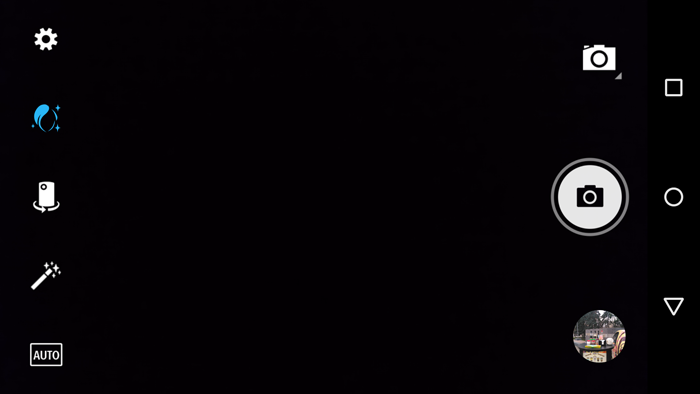



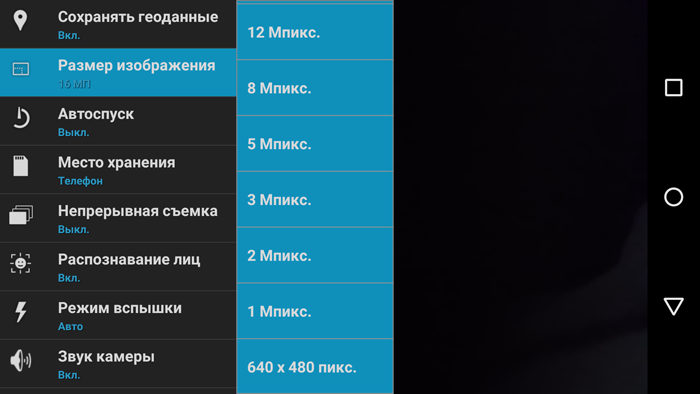
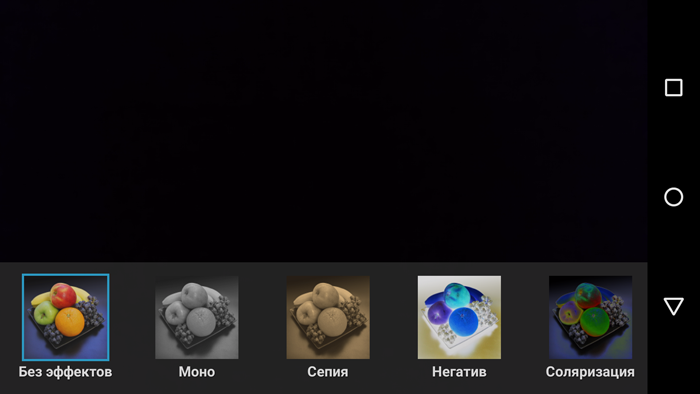
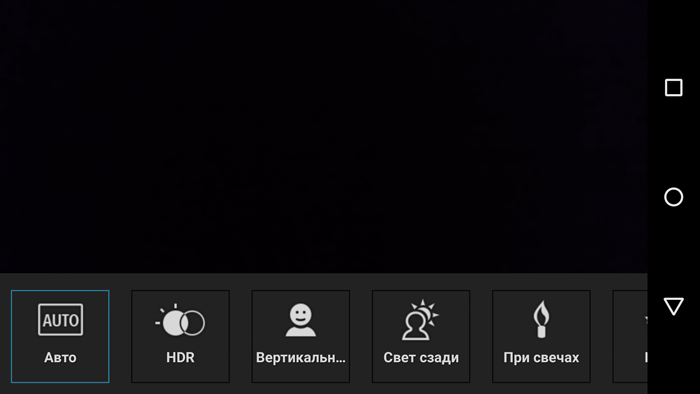
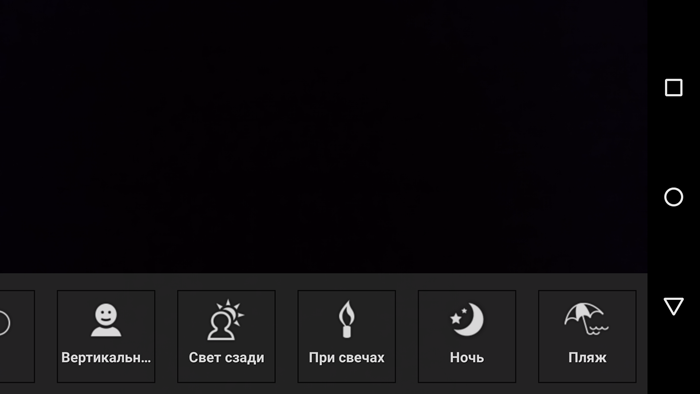
Exactly the same settings are available when switching to the front camera, only the resolution selection is limited to 5 megapixels:
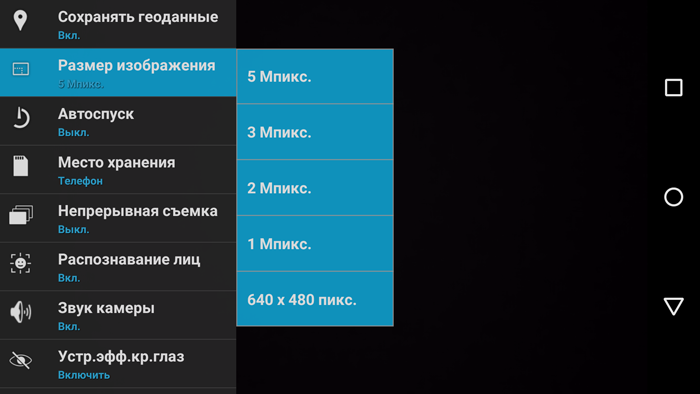
Settings when shooting video with the main camera:

Settings when shooting video with the front camera:

When photographing, the focus automatically occurs in the center of the frame, but if you wish, you can click on the screen in the right place, and the camera will focus on it.

On the quality of images on the main camera, I can say the following. innos D6000 is well suited for daytime shooting - the pictures are detailed and sharp. Of course, sometimes there is a "soap", but this is extremely rare. Maybe once out of 10 - as a rule, if the hand shook when shooting. Among the shortcomings, I note the fact that when photographing nearby objects (and, by the way, not only nearby ones), the sky in the frames often becomes milky-white, although it is actually blue or gray. The smartphone allows you to get good macrophotography. But the night shooting is clearly not his strong point, which is not surprising at an aperture of f / 2.2. The flash "pierces" a couple of meters, but I do not recommend using it for shooting nearby objects in the dark - they turn out to be white.
Daily shots series:









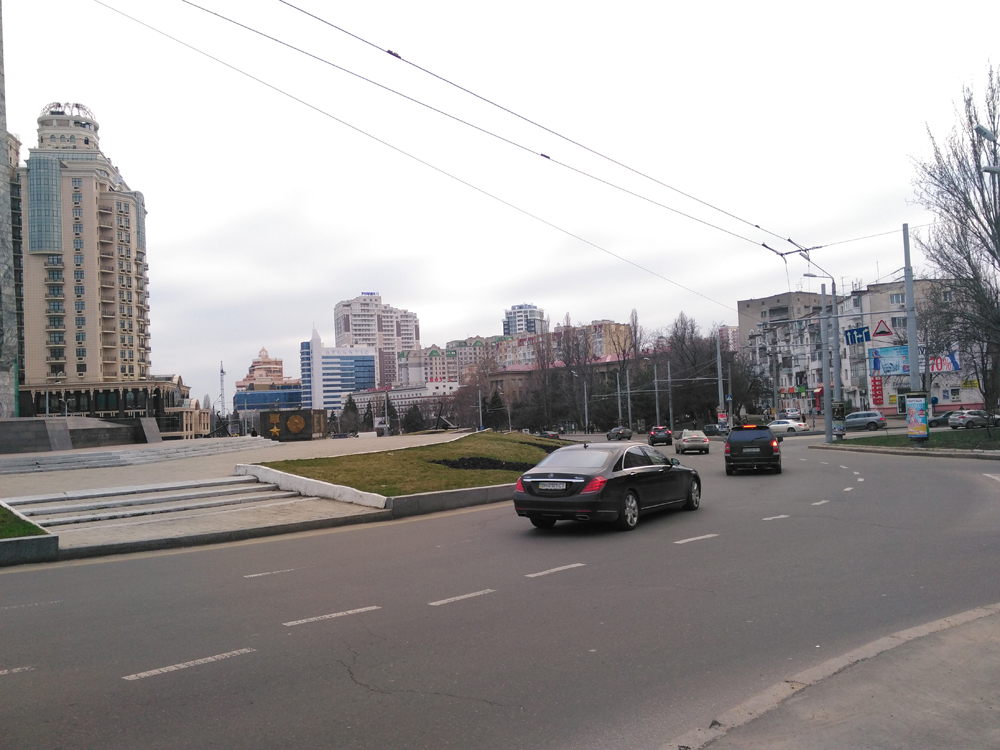


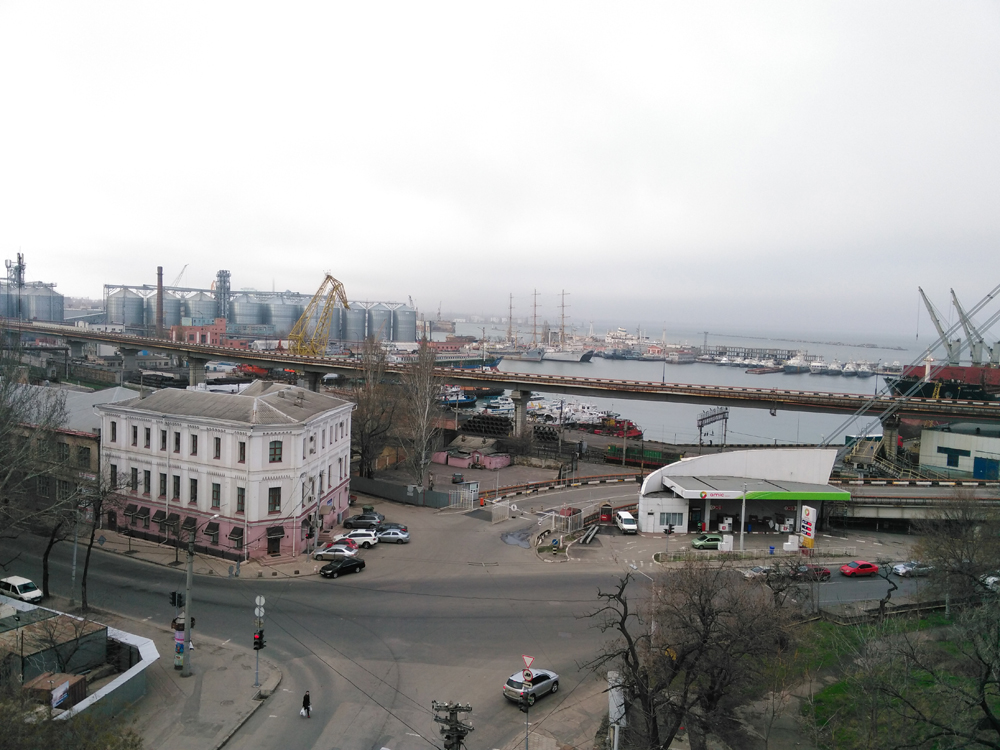


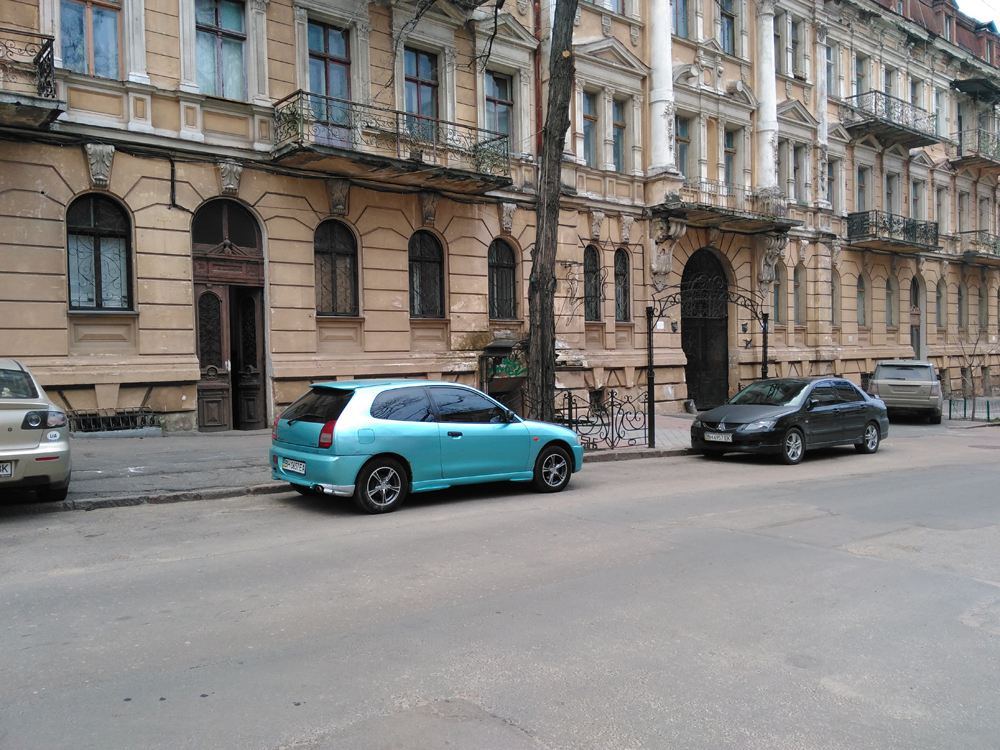




Images under artificial light:

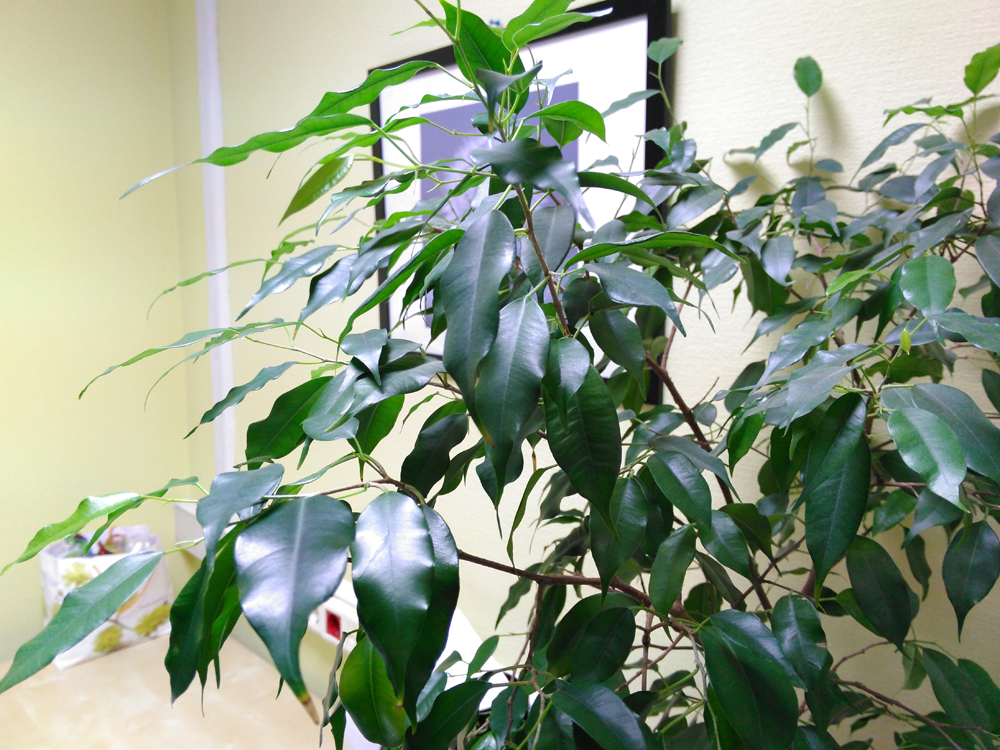


Macro:

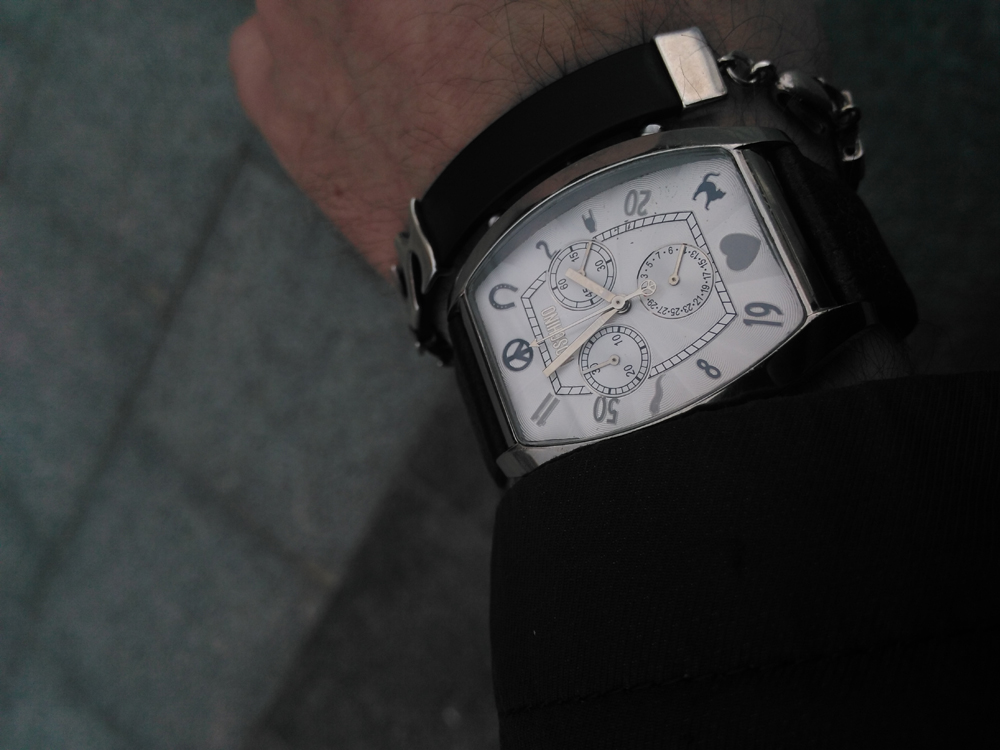
Separately, give a few pictures of the text:

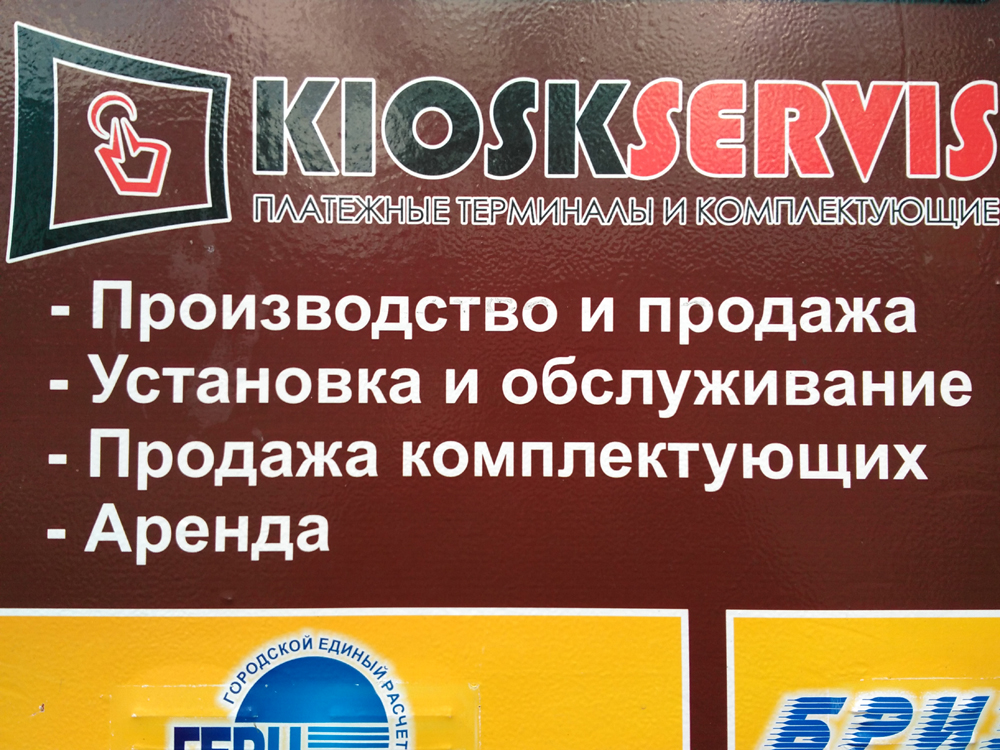



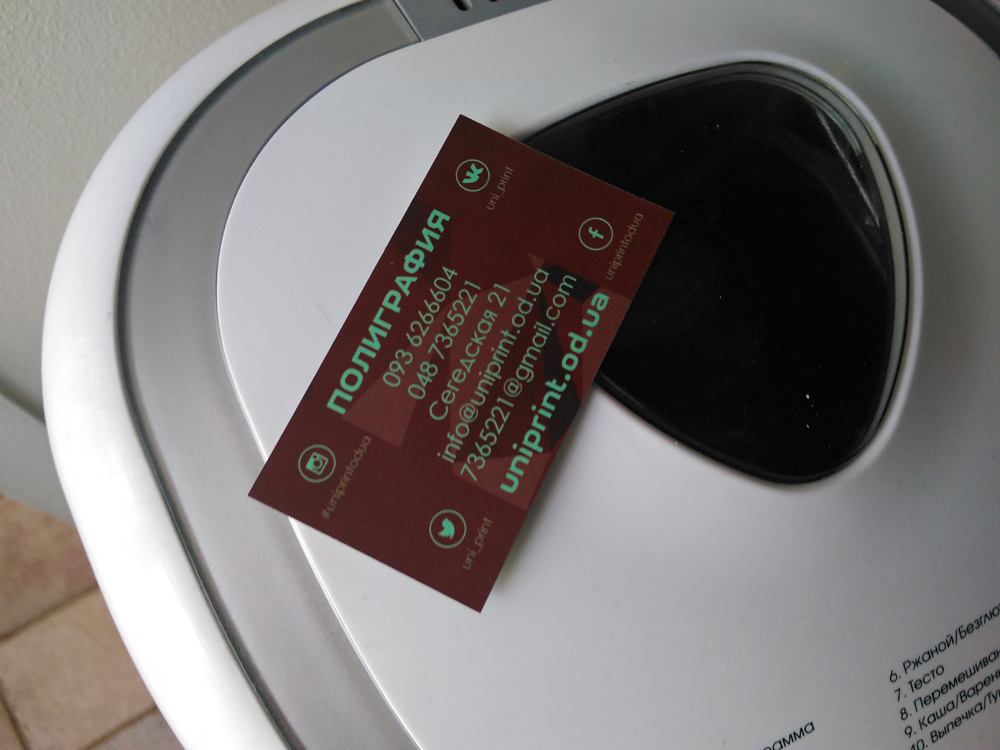
Night shooting. In the presence of bright artificial light sources (left), the frames are more or less decent, in the absence of such sources (right) - so-so:


Sometimes you can call for help HDR mode. Left night shot without him, right - with him:


Nearby objects, that is, a couple of tens of centimeters away, flash flashes (left), but located a couple of meters away you can take it with quite decent quality ( on right).
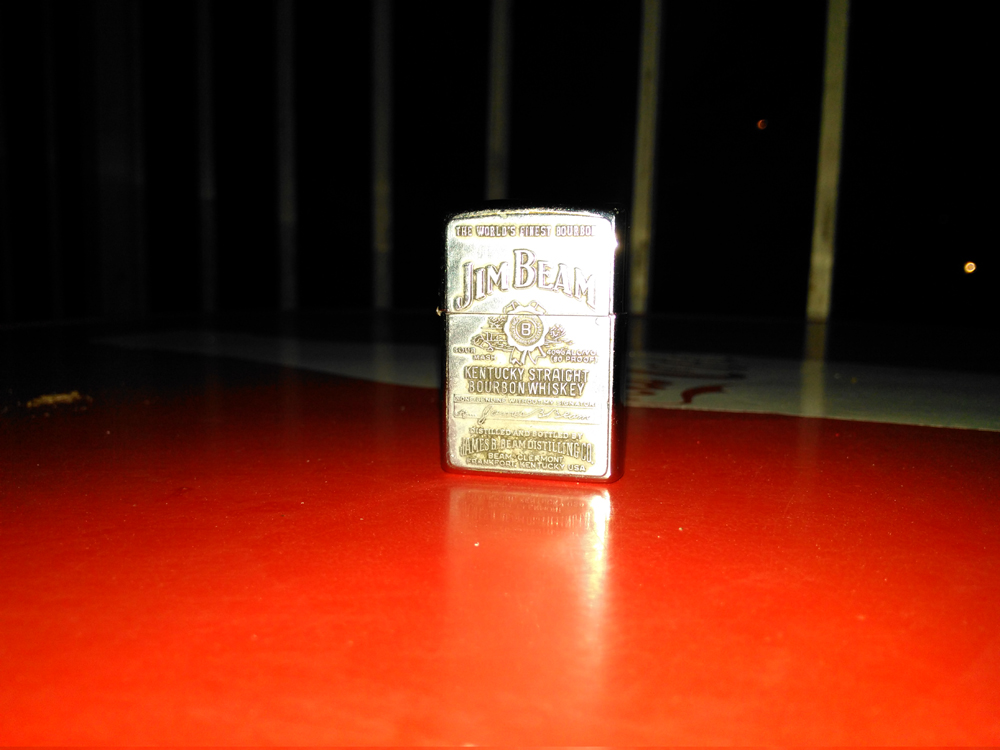

Examples of panoramic images. I will not say that innos D6000 copes very well with such frames. That is, the device “sticks together” is almost perfect, but the detailing is not very high.


Photo on the front camera. I can state that the innos D6000 is quite suitable for the "crossbow". Despite the lack of autofocus in the front of the camera, the pictures are clear.


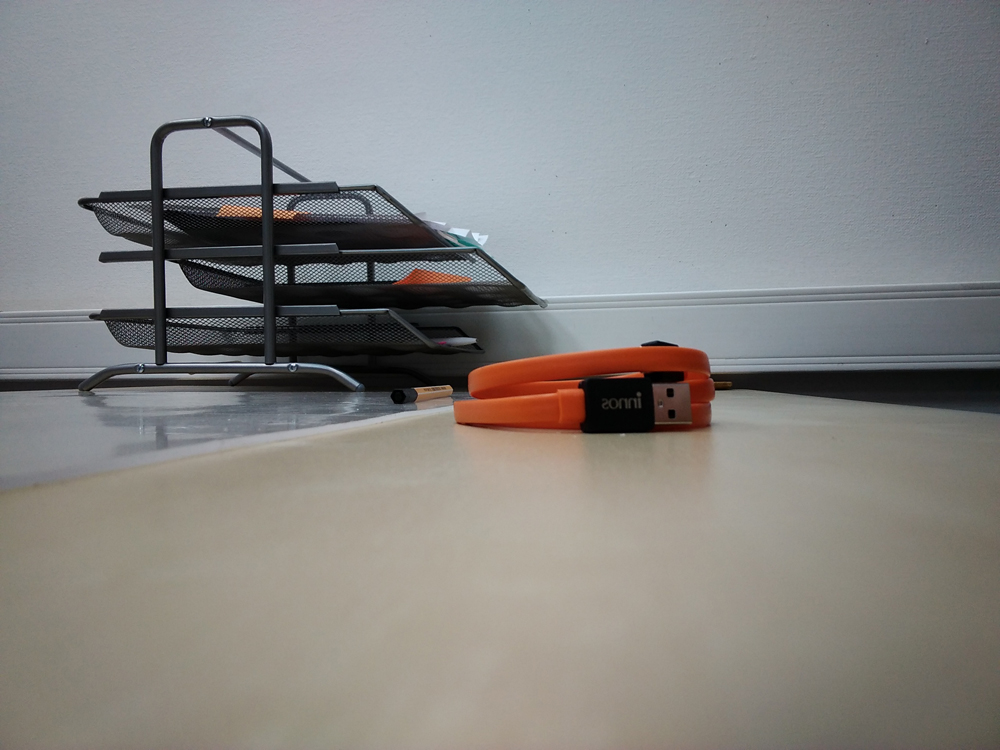

Everything is not bad with video - innos D6000 writes videos quite at the level of competing (and even more expensive) smartphones. Resolution can be up to 1920 x 1080 pixels.
Examples of video on the main camera (Full HD 1080p, 30 frames per second):
An example of video on the front camera (Full HD 1080p, 30 frames per second):
:
https://www.dropbox.com/s/s2x8wpuvgbofmuj/innos%20D6000.rar?dl=0
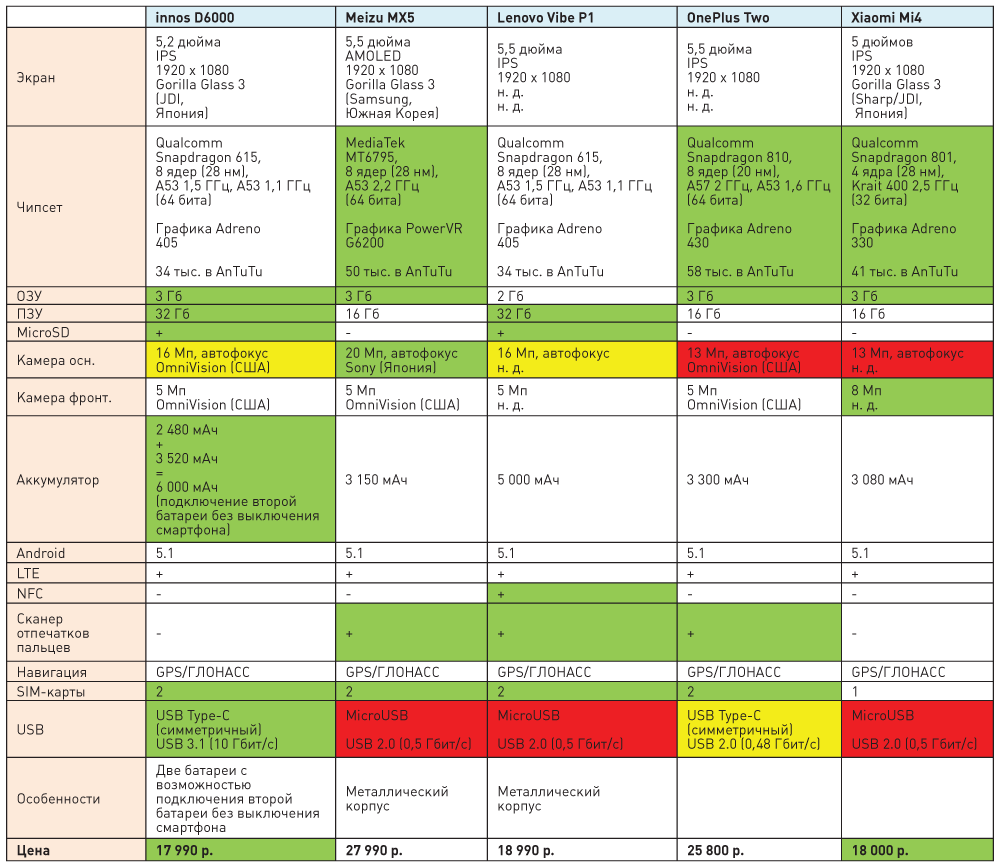
I compared the innos D6000 with several other Chinese smartphones. Closest to the innos D6000 for price and performance is the Lenovo Vibe P1. It has the same chipset and a slightly less powerful battery - at 5,000 mAh (just one, not two, like the D6000). What I personally don’t like about Lenovo is the absolutely awful branded shell for Android (the shell I generally like, but obviously not), it’s better to have a “pure” Android. More Lenovo Vibe P1 is less RAM (2 vs. 3 GB), but it has NFC and a metal case. innos D6000, in turn, wins at the expense of the USB Type-C port and the price, which is 1,000 rubles lower. I do not dare to discuss the form factor, someone closer than 5.2 inches, someone - 5.5. Yes, and also: for innos D6000, they are guaranteed to release the firmware from Android 6.0 Marshmallow, but for Lenovo Vibe P1 - not sure.
For about the same money as in the case of innos D6000, you can take the Xiaomi Mi4. It has one SIM card slot, less capacious battery (3 080 mAh), no USB Type-C. But more powerful iron. Well, here it depends on who needs what - as I said above, Snapdragon 615 is enough for all tasks today.
OnePlus Two seems to have USB Type-C, but the interface is actually version 2.0. The glass on the screen is nameless, and the Snapdragon 810 chipset, despite all its theoretical power, has proven itself the worst way (I'm about overheating - see the section on hardware D6000). Battery rather weak for 5.5 "... In general, a muddy machine, I would not buy it myself. Especially for 26 thousand rubles.
The Meizu MX5 is, so to speak, a typical Chinese flagship of the end of 2015 - beginning of 2016. Metal, AMOLED, 50 thousand points in AnTuTu and a 3 150 mAh battery. Well, the price is 27,990 rubles. The option, in general, is worthy if you do not mind giving such a sum for the “Chinese”. In my humble opinion, the device with a price of 20 thousand rubles and at the current rate should already have a certain image charge. I don’t know if the Meizu smartphone can provide it - with all due respect to this brand.
In general, what I am all about: for my money - 17 990 rubles - innos D6000 offers, perhaps, the best set of characteristics for today. The battery, the screen, USB Type-C, the camera, the amount of RAM and internal memory - the competitors have all or worse, or the same or better, but then they cost more than one and a half times. Differing at the same time twice less capacious battery.
I am extremely annoyed by the autonomy of many modern smartphones. Yes that many - almost all. With my model of operation, the average 5-inch device with a 4000 mAh battery is discharged in two days. A smartphone with a similar diagonal and a battery capacity of 2 500 mAh - about a day with a little. Against this background, I pinned special hopes on innos D6000. The device has a built-in battery for 2 480 mAh and a removable battery for 3 520 mAh (both are lithium-polymer), and in the case of the latter, hot-swappable is supported. This is a unique scheme - as I said at the very beginning, it was developed in innos and has no analogues on the market. What is the salt? In my opinion, in the following: you can buy as many external batteries as you like (at least 5, at least 10) and eventually get something like a smartphone with a “perpetual motion”.Discharged battery - replaced it with a charged one. Then another, and so on. At the same time, you do not need to turn off the smartphone and wait until it turns on, thanks to the built-in battery. Though during the conversation cut down!
The pattern of energy consumption in the innos D6000 is as follows: first, the external “acc” is discharged to 85%, then the internal is discharged to 85%, then the external to 1%, then the internal is connected and also “emptied” to 1%. This is done to ensure that both batteries work regularly, which prolongs their lifespan.
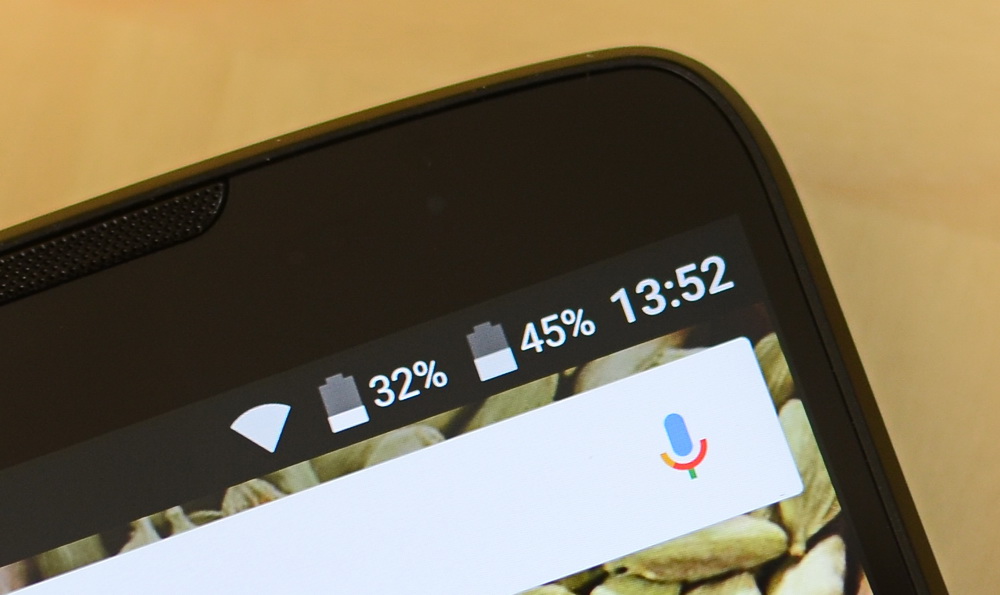
There are several other situations when a similar design - with one built-in battery and one removable - can be useful. First, when the smartphone is dropped. I think many have come across a situation where you drop the device, the battery crashes, and the smartphone, as a result, turns off. In the case of innos D6000, this is impossible in principle: if you drop it and the external battery jumps out, it will not turn off. Finally, there is a certain wow effect: it makes an indelible impression on untrained spectators when you remove the battery and the smartphone continues to work. Everyone is surprised, including girls;) The most unusual review was given by my friend, who has lived in China for a long time and has long ceased to be surprised by technical curiosities: “Aha, the battery is not real!”
As for my hopes, they were justified in full –6 000 mAh, this is really a lot. I talk for about an hour a day, for about two hours a day I play Asphalt 8, surf the Internet regularly through eager to charge a Chrome battery and get about 40 emails a day via Gmail. In this mode, the innos D6000 works for about 3 days, sometimes less for a couple of hours, sometimes more. And just recently, I had a week-long vacation: I did not receive any letters and had a rest from the Internet - that is, if I watched web pages and social networks, then from a computer. In general, in innos D6000 I talked for about an hour a day and took a couple of photos. The device worked 6 days and 11 hours. Bravo!
I note that in the two situations listed above (“normal mode” and “vacation”), the device worked on 3G networks, since there is no LTE in Ukraine yet. (The screen brightness is set at 50%, during the day there are regular Wi-Fi connections.) But in February I had a business trip to Moscow, where LTE networks do exist. In normal operation with movies and “Asphalt”, the same three days came out, that is, I did not fix any difference with the work in 3G networks.

Familiarized with the table? Now it is worth clarifying a few points. Firstly, in your particular case, the innos D6000 can work both a little longer and a little less. Why?Because a) you may have a different firmware (for example, a month after you read this review, an update will be released where something is “finished”); b) in parallel with the video or game, you can have any active energy application running; c) I assume the influence of any unobvious factors - the level of the network signal, distance from the router, ambient temperature, location of the planets of the solar system, and so on.
The second point, which should be clarified, is that the individual Samsung and Apple devices and on a battery with a capacity of up to 3,000 mAh can, for example, twist video around 10 hours or even more. But!These are, firstly, flagship models with a price of 50-60 thousand rubles. And they use their own chipsets from these companies. Not only are these chipsets, as a rule, 14-nanometer (against 28 nm for innos D6000 and 99% of all other devices with similar price tags), so also the “home” development of the hardware platform allows you to optimize power consumption at the device design stage . Meanwhile, innos, as well as HTC, Sony, LG and other manufacturers that do not have their own chipsets (ok, LG has, but very few people know about it), are forced to use what MediaTek and Qualcomm offer. With the corresponding consequences: their power consumption is higher than that of devices on Exynos and Apple Ax. And if you compare innos D6000 with regular Android-smartphones on Qualcomm chipsets, the performance is more than worthy.The “autonomy” time here depends a) on the capacity of the battery and b) optimization of the software. Both with the first, and with the second at innos D6000 everything is all right. Analogs with batteries with a capacity of 2 500-3 000-4 000 mAh work proportionally less.
I also note that the device has a power saving mode. It decreases performance, limits the use of geolocation, background data transfer, and so on. According to my observations, when activating this mode, you can achieve a gain of one and a half to two hours of battery life, for example, when watching a video. At the same time, the device becomes slower, when opening applications and navigating through the menu, there are small friezes.
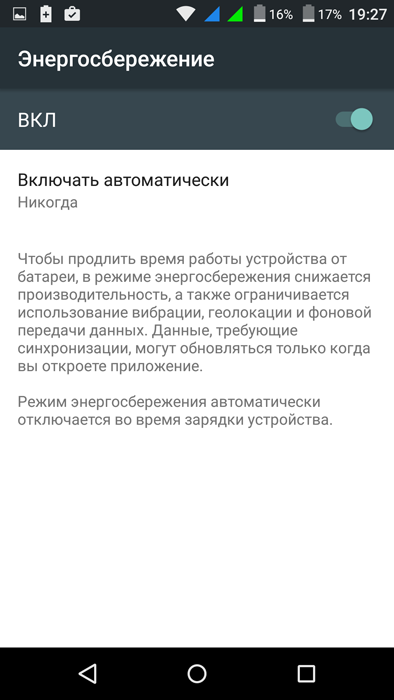
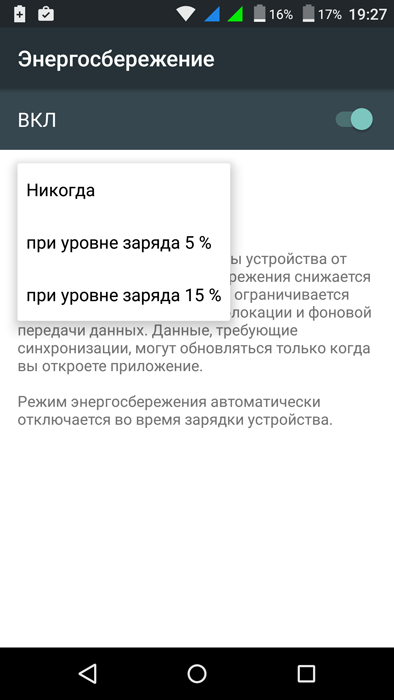
The innos D6000 charges for about 3 hours, and the removable battery and the built-in battery “saturate” simultaneously. 3 hours for such a capacity - the result is very good. Probably, Qualcomm's Quick Charge 1.0 technology, which is implemented in innos D6000, should be “blamed” for its achievement. Yes, the version is not the freshest (Snapdragon 615 supports both 1.0 and 2.0, the choice depends on the developer of a particular device), but it's better that way than without fast charging at all.

It is no secret that innos D6000 was introduced in the first half of 2015, and since then it has appeared on sale on the mass of Chinese sites - for example, the same AliExpress. However, a completely different version of the D6000 was prepared especially for Russia and Europe. Differences begin in the configuration: with the "Russian" device comes a charger with a plug that is familiar to us, but in the case of a "Chinese" the plug will be flat. That is, it is necessary to re-buy a special adapter.
The second important difference is the back cover. The D6000 version for Russia and Europe received a panel of matte polycarbonate and with a larger innos logo. Moreover, the logo is not printed, as in the Chinese version, but embossed on the surface, so that over time it will not be erased and will not fade. By the way, the version of the smartphone, which can be ordered from China, the back panel is smooth and matte. I dealt with such a modification of the D6000, and I must say that scuffs and scratches appear pretty quickly on the matte cover. So the "soft-touch" of the Russian version is preferable.
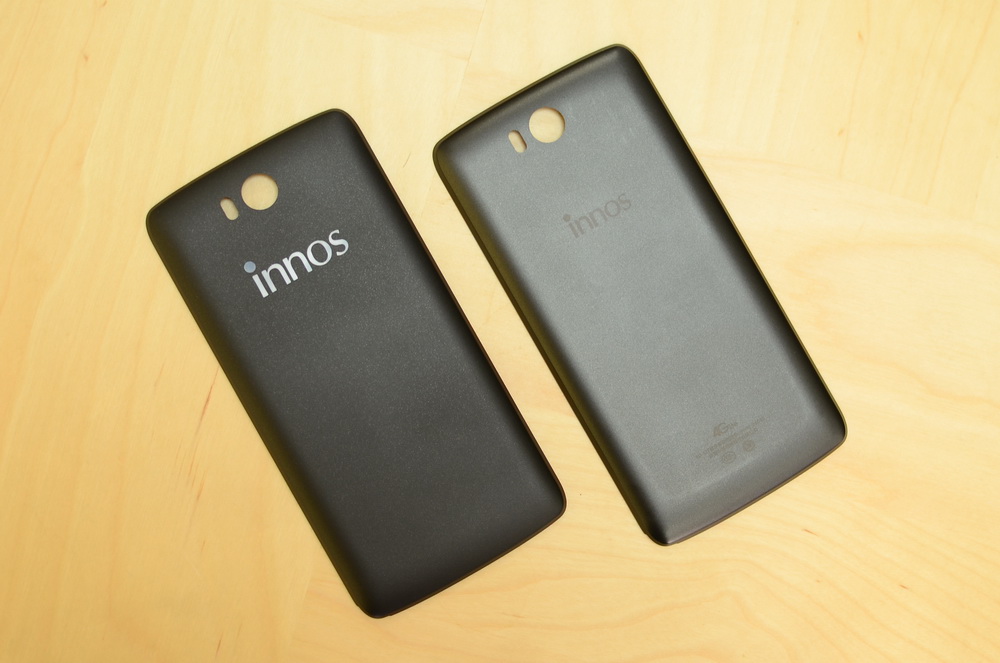
Back cover version for Russia (left) and back cover version for China
The third important point is LTE support. Chinese versions support only “bands” 1, 3, 7 and 20, and the innos D6000 variant for Russia also has 38 and 40. Band 38 is used, for example, in Moscow by MTS and MegaFon operators, so ideally any smartphone should support him. Want a D6000 to work with them? Well, take a modification for the Russian market!
The remaining differences are in software. The innos D6000 version for Russia and Europe comes with a fully russified firmware of the latest version, in which all minor and not very bug fixes are detected by both the innos engineers and users. And such devices work completely stably - I speak with all responsibility, checked on myself. And then you read the forums where the owners of the innos D6000 versions for China communicate - and you wonder: it is buggy, it does not work, they get out hieroglyphs, there is no Google Play here, the network does not catch ... It is understandable: these devices are not designed for operation in our latitudes, hence the problems. Meanwhile, innos D6000, intended for Russia and Europe, I repeat, is deprived of all this. And yet this version of the device - which is very important - has been tested for compatibility with all Russian cellular operators.
Finally, something about the guarantee: the official “Russian” copies of the innos D6000 are provided with a one-year guarantee, the buyer is protected by the law “On Consumer Protection”. But the owner of the "Chinese" version ... Well, you understand.
It is nice that along with innos D6000 in Russia, branded accessories for this device are also offered. And then I came across situations where for a particular exotic smartphone it is impossible to pick up a case or, for example, you have to cut a protective film - due to non-standard diagonal. So, for innos D6000 the following branded add-ons are available:
· Silicone covers of orange and black colors (390 rubles). They are pleasant to the touch and not much thicker smartphone, just a couple of millimeters. I draw your attention that these are covers, that is, they cover both the sidewalls and the back of the device. But they do not have a flip to protect the screen - they do not plan to release a cover with this component in innos yet.
· Charging unit for 2 A with support for fast charging (490 rubles). The same goes in the kit.
· Orange Type-C USB cable with a length of 1 meter (390 rubles). The same goes in the kit. By the way, pay attention to the price - check and checkmate to those who say that such laces are fabulously expensive today. A second cable can be purchased, for example, so that the innos D6000 can be charged at work and at home without having to carry the cord back and forth. Well, or just in reserve.
· Protective glass from Japanese Asahi strength of 9H (490 rubles). It is much stronger than conventional film, which is glued to the screen of the D6000 at the factory. Gorilla Glass 3 + Asahi safety glass = almost armor-piercing screen protection.
· Removable battery at 3 520 mAh (990 rubles). You can buy as many external batteries as you want. And each of them will provide up to 4 and a half hours in games, up to 9 hours of video viewing, or up to 4 days of work in the “economy” mode. But there is also an unpleasant moment: you can only charge removable batteries in your smartphone, that is, there is no brand cradle for charging them either in the kit or for extra money. However, no one forbids you to use the "frog";)
Group photo of branded accessories:

The results are simple. innos was really able to offer the market something new and impressive in terms of technology and so-called usability. I repeat: previously, no one made devices on Android, which could work on two batteries at the same time. But innos were able to implement such a thing, having added this chip with a very good 5.2-inch screen, USB Type-C port, 3 GB of RAM and other small and large goodies. When you see the specifications of the innos D6000, you expect that the price of the device will be somewhere around 22-25 thousand rubles. But here we are in for a pleasant surprise - 17,990. So ... The offer is excellent. And without any serious flaws, unless, of course, attributed to those not too expressive brutally masculine design.
I really liked the device - I did not even expect it directly. And, not least, this cheap Chinese here (just at the level of sensations and emotions), like the Russian brands of smartphones, is not mentioned here. innos D6000 is a cool modern smart-level model for LG, HTC, Xiaomi and other popular brands. It can be seen that when creating it they did not save - and it’s very cool that thanks to direct sales the company managed to “draw” such a pleasant price tag for Russia.
The Chinese company JSR, owner of the brand innos, was founded in 2009. She specializes in the production of smartphones with large-capacity batteries. When creating new smartphones in innos, they rely on top-end "stuffing" from global manufacturers. In particular, innos partners include Sharp (screens), Sony and OmniVision (camera modules), Corning (Gorilla Glass glass for display protection). But the most important thing is cooperation with the US manufacturer of chipset Qualcomm. Moreover, JSR has the status of a certified partner , so fresh innos chipsets get a bit earlier than many other Chinese manufacturers. Moreover, innos is seriously refining Qualcomm solutions. So, none of the platforms of the American chip maker initially could not work with two batteries at the same time, but innos on their own solved this problem and realized not only the work from two batteries, but also the possibility of hot-swapping one of them. And they released a smartphone innos D6000, which, in fact, is the hero of this material.

JSR / innos now has more than 500 employees, and it was launched with a core of 30 engineers - people from the R & D divisions of ZTE, Huawei and Motorola. I will stress, as they say, two times: JSR is not just another contract collector, but really a large technological company with its development centers, laboratories, and its own factory. This is a company at the level of OPPO, Meizu, and so on - in short, another one of these young and daring Chinese manufacturers.
')
Dear reader, most likely, I have already come across innos products. Or at least heard of her. In 2012, the innos D9 smartphone, known in Russia as the DNS S4502 and Highscreen Boost, was released. It became the world's first Android-background with a battery capacity of over 4,000 (4,160 mAh).

innos D9
A year later, the innos D10 smartphone appeared with a 6,000 mAh record battery at that time. In Russia, it was sold as Highscreen Boost 2 (later an improved version of Boost 2 SE appeared).

innos D10
These models were created in cooperation with Russian local brands. And so JSR had to significantly save on technology and components. Well, how else, if the products DNS and Highscreen are sold in the usual retail with its “horse” (up to 30-40%) wraps? In order for the price tag to remain “tasty” after all surcharges, it was necessary, at the request of these same local partners, to look for ways to reduce the prime cost of the devices. How? Plastic is cheaper, screens and cameras are simpler, less factory testing ... And so on.
At the end of 2015, JSR entered the European and Russian markets under its own innos brand. Innos devices are sold exclusively in the brand's online store and are shipped directly from the factory to end users. In retail networks, it does not make sense to look for innos devices, but the online format of sales helps to avoid unnecessary cost increases. Innos say that it allows not to save either on technologies or on components. All that “local partners” and retail chains would “wind up” will go to price reduction, as well as to increase the level and quality of the offered devices.
Separate material in which all aspects of innos entry into the European and Russian markets are covered can be found here .
In general, today we will talk about innos D6000. This is the newest product of the brand, designed to conquer the Russian and European markets of long-lived smartphones. And he really has something to surprise. First, the innos D6000 is the first and only smartphone in the world that can work without a battery. Do not believe? See for yourself:
Secondly, it is the first and only smartphone in the world that can operate on two batteries simultaneously and with the ability to “hot-swap” one of them. Thirdly, innos D6000 has the most powerful battery on the market - 6,000 mAh, which provides up to a week of work without recharging. Fourth, it offers the best features for 17,990 rubles. However, by this time we will be back.
Specifications
Operating system: Android 5.1.1 Lollipop (a quick update is promised to 6.0 Marshmallow)
Display: 5.2 ", Full HD, 1920 x 1080 pixels, IPS, 424 PPI, manufacturer - JDI (Japan)
Safety glass : Corning Gorilla Glass 3
Chipset: Qualcomm Snapdragon 615 (MSM8939), 8 Cortex-A53 cores (4 to 1.5 GHz + 4 to 1.1 GHz)
Graphics accelerator: Adreno 405 (up to 550 GHz)
RAM: 3 GB
Flash Memory: 32 GB
Memory Card: MicroSD up to 32 GB
2G network: GSM / GPRS / EDGE 850/900/1800/1900 MHz, 4G LTE
3G network : WCDMA / HSPA + 850/900/1800/2100 MHz
4G Network : LTE Cat. 4 (up to 150 Mbps), B1, B3, B7, B20, B38 and B40
Wireless: Wi-Fi 802.11 b / g / n (2.4 GHz), Bluetooth 4.0 LE
Camera: 16 megapixels (OmniVision module, USA), BSI II, autofocus, LED flash, F / 2.2
Front camera: 5 megapixels (OmniVision module, USA), BSI +, F / 2.2
Ports: USB 3.1 with balanced Type-C, OTG, 3.5 mm audio jack (CTIA pinout)
Navigation: GPS, GLONASS, Beidou, A-GPS support
SIM card: microSIM + microSIM in Dual Standby mode
Batteries: 2,480 mAh (built-in) + 3,520 mAh (removable) = 6,000 mAh
Dimensions: 144 x 72 x 11.9 mm
Weight: 188 g
Optional: accelerometer, gyroscope, e-compass, proximity and illumination sensors
Price: 17 990 rubles.
Packing
innos D6000 comes in a compact cardboard box of bright pumpkin (or carrot?) color. The Chinese version was sold in a box with a camel logo. The association is direct: a camel can plow the desert for months, doing without food and water thanks to a pair of its large furry humps. So innos smartphones can also work for a long time without recharging - though not months yet, but weeks. Packaging, by the way, is not cheap - it is immediately obvious that we are dealing with a product practically from the A-brand, and not from an anonymous “budget” Chinese. Inside the box there are “dividers”, the device itself is in different compartments with a protective film glued on the display ...


... as well as a power adapter, an instruction booklet and a 1-meter USB-USB Type-C cable. The cable, by the way, is bright orange: you immediately notice it in the room, and because of the color, this “string” cannot be confused with the black and white cables that smartphones usually come with. This is how the cable from innos D6000 looks like among other wires - it can be seen immediately:

This cable is inserted into the corresponding port of any of the parties, which means that the famous problem of “ USB superposition ” is missing here. In other words, we have an analogue of Lightning from the latest generation iPhone - that is, a symmetrical port and plug. It is very convenient! In my humble opinion, USB Type-C is generally the best of all that has been implemented in Android smartphones over the past three years. All these apertures and volumes of RAM seem so, um, insignificant, when you, completely tortured, at 12 at night you want to quickly put the phone on charge and flop into bed, and then it turns out that the microUSB plug, damn it, DO NOT insert. Because it had to be inserted by the other side. You insert another - and he still does not climb. I think every reader has ever been in such a situation at least once. In general, give symmetry. And do not listen to young green observers from sites about gadgets that whine that, they say, USB Type-C - it is still rare and expensive, they don’t have many cables for such a port, you have to carry with you Smartphone does not charge, and so on. That they, sorry, just show off.

USB Type-C (right) and Lightning plugs

MicroUSB and USB Type-C: Give Symmetry!
Here, in fact, the equipment package:




I note that the wired headset is not included. In my opinion, the approach is correct: normal “ears” would not be put anyway, but you do not want to pay for cheap ones. If you regularly listen to music from any gadget, then you probably have decent headphones with a “warm tube sound” (as is customary to write with electronics reviewers).
Design and ergonomics
The case design is not the strongest side of this device. A well-rounded “bar” of coal-black color looks quite simple and inconspicuous. The device is made in the spirit of minimalism: neither the front panel nor the back side is replete with design elements. A typical "workhorse", resembling from the front whether LG Nexus 4, or LG Nexus 5.






Above the display are a speaker, a front camera eye, light sensors and proximity sensors, as well as a LED indicator of various events. He blinks orange. On the one hand, it’s good that it exists at all, but I’m not able to see such a component in all smartphones. On the other - it can burn only one color. For example, on my Samsung Galaxy S5 (I understand that this is the flagship with all the consequences, and yet) the indicator lights up in different colors - for example, when it receives mail, it flashes blue, and when it receives a personal message from VKontakte, it is turquoise. So only one available color for all events is, in my opinion, some omission of designers. On the other hand, it’s better this way than without a diode at all.

At the bottom are two speakers. More precisely, not quite. There is only one speaker on the right side. On the left, just a similarly shaped hole is for symmetry. It has a “hidden” microphone. It would seem, well, let the speaker alone - do not worry. But! When you play, say, in Asphalt 8 or in Angry Birds, you block the speaker with your finger, and the sound is muffled once every five. You can, of course, flip the device and eventually achieve a position where the fingers do not overlap anything. But not everything is so simple: the same Asphalt 8 can reorient the image, but Angry Birds - no longer. And in the case of "Birds" the speaker will always overlap with a finger. We have to master the new grip, like that of coffee-drinking aristocrats - with a bulging little finger. However, users of “iPhone” do not live with this for the first year - and nothing, they do not complain, but are even satisfied.

In the location of the speaker on the bottom of the case there are pluses. The sound is not muffled when the unit is on the table. The sound, by the way, is average in quality. That is, the maximum volume is high, you can not argue with that, but the device plays "flat". Until complete happiness is not enough detail and bass. However, it depends on what to compare. The same Galaxy S5 "sings" is never better.
Here, perhaps, I would say that the vibration of the innos D6000 is average in strength. You feel it in your jeans pocket without any problems, but in the pocket of your winter jacket you no longer have it. By the way, when the called subscriber picks up the phone, the device vibrates for a second - a pleasant and convenient change, you know, when you can start to “alekat”. I remember a similar feature was in the old HTC based on Windows Mobile.
Between the speaker and the second hole, imitating the speaker, is the USB Type-C port. About him, I have already spoken above, so I will not repeat. I will add only that the USB 3.1 interface is supported with a maximum theoretical speed of up to 10 Gb / s (versus 0.5 Gb / s for USB 2.0).
On the left side is a twin key ("rocker") volume control.

At the top of the case are a 3.5 mm headphone jack (CTIA pinout) and a second microphone. That is, there are two of them in the device, due to which a noise reduction system is implemented. Actually, the quality of speech transmission is quite decent, the interlocutors hear me well always and everywhere. I did not notice in this respect any difference with the iPhone 6, nor with the same Samsung Galaxy S5.

On the right side of the case there is a power button and a multifunction key.

The latter can be reprogrammed - all applications are available for assignment, both pre-installed on the smartphone and downloaded from Google Play and any other sources. For example, on this button you can hang up the function of creating a screenshot or “shutter” of the camera. Just do not forget that the level of pressing a button is only one, and this means that you will have to focus by pressing a finger on one or another area of the screen, and now you have to take a photo with a button.


All hardware keys protrude about 0.7 mm above the surface of the case and have a clear stroke. That is, under the finger they don’t hang around here and there and do not rattle, which is nice. I have seen a similar thing more than once in Highscreen smartphones - including in Boost 2. And this is just an example of savings due to an attempt to make a device sold through retail networks cheaper: they didn’t test, they didn’t observe tolerances - and you! It is pleasant to note that in innos D6000 everything was thought out much more carefully.
The back cover of the innos D6000 is removable, it is made of polycarbonate, which at first glance (and the first “probe”) looks like the good old soft-touch. But this is exactly matte plastic, that is, it will not peel off or collect scratches, no. It will collect dirt, and quite successfully. Fingerprints appear within 10 minutes from the moment you start using your smartphone. However, they are scrubbed easily - for example, with a napkin or about a shirt.

In order to remove the back panel, you need to insert a nail into the slot on the lower left corner of the device and pull up. Under the cover is a removable orange battery - in the tone of a complete box. Let me remind you once again that the device has a second, internal battery - NOT removable. It is not visible at all - it is inside the case and cannot be removed at home without a screwdriver. (You can, of course, unzip the device, but then say goodbye to the guarantee, and even to the smart itself.)



The battery closes two microSIM compartments and one for the microSD memory card. All three sockets have a design with folding metal panels that hold the cards in their places. But microSD is still just a bit more complicated: a flash drive is inserted into this socket, which for me personally was not obvious. Therefore, I was able to install a map of times from the fifth.

I consider it necessary to note that the design of the slots for SIM-cards in the innos D6000 allows using the NanoSIM cards without any problems. The same Galaxy S5 and other devices with “slot” slots for “simok” cards with the smallest format have serious problems: you can insert it, but not the fact that you can “center” correctly and then pull it out.

Innos D6000 is conveniently located in my hand, even I with my not very large paws easily reach all the keys. When the removable battery is installed, the weight of the device is approximately 190 g. Without it, the smartphone “drops” 63 grams. These numbers surprised me, I expected to get a prototype of a “brick” weighing no less than 300 g. Another plus in the device's box! Although, I must honestly admit, the innos D6000 turned out to be a purely masculine machine - for the ladies, it is clearly big and thick. For the weaker half of humanity there is a mass of super-thin super-lightweight models with small batteries, which, by virtue of this particular feature, are not suitable for everyone. So ... I have to choose: either the device is elegant, but it asks for a charge once a day, or a mobile phone is well-fed, like innos D6000, but it works for a really long time. I - for the second option. You take the D6000 in your hand - and immediately understand: the thing! No here here these ostentatious graces and other ryushechek. Only hardcore.

innos D6000 in male hand

innos D6000 in a female hand

The girl speaks on innos D6000
There are no complaints about the build quality: there are no excessively wide gaps between the panels and the play of the body elements. That's just without a removable battery, the back cover bends slightly when pressed. This was to be expected: if the battery is not installed, then empty space is formed under the panel. An investigative experiment showed that this empty space can be used as a cache - a bank card or a small stack of folded bills are placed. It is very convenient if you don’t like it when there are a lot of foreign objects hanging in your pockets, or you don’t want to lose all valuables at once.


Display
The display is built on an IPS-matrix from the company JDI (Japan) and does not have an air gap between this matrix and tempered Corning Gorilla Glass 3. That is, the device implements OGS (One Glass Solution) technology. The colors are bright, the picture on the screen is vivid and clear, although there is a slight departure in cold tones. There are no settings for color rendition, as in separate smartphones on MediaTek chipsets (these tools are called MiraVision), in innos D6000. However, it was not very desirable: these very “cold tones” will be noticed only by very picky aesthetes. What the screen can be praised for is the normal black color (and not dark gray, like inexpensive IPS-matrices) and wide viewing angles - when the smartphone is rejected, the picture almost does not fade.







Macro display
The diagonal of the screen is nonstandard: not 5 inches, not 5.5, but 5.2 - like that of the Motorola Droid Turbo. I must say that this is a great option in order to make the smartphone more convenient compared to typical 5-inch devices, but at the same time and not to turn it into a "spade" with all the consequences. The resolution is 1920 x 1080 pixels, that is, Full HD. For such a diagonal is more than enough. In general, I do not really understand why putting QHD-matrixes into 5-inch smartphones: the difference from Full HD is not visible, and the load on the battery and iron is significantly increased.
By the way, the matrix in innos D6000 is “thoroughbred” - it was released by the Japanese company JDI, an alliance founded by Sony, Hitachi and Toshiba. As you understand, on the high-quality matrices, these comrades have not eaten one doggy (although the Japanese, not the Koreans). JDI delivers screens, for example, for selected top-end smartphones Xiaomi and Sony, as well as - that's your time! - YotaPhone first generation.
Oleophobic coating and anti-glare filter are present - and these are signs of an expensive quality product. In the budget Chinese smartphones and models of local Russian brands of these options, as a rule, no. Touchscreen, of course, capacitive (when was the last time you saw a resistive touchscreen on your smartphone?), Up to 5 simultaneous touches are supported. I would like, of course, 10, even if I don’t quite understand - why. As they say, Schaub was.

The display is covered with a factory transparent film. I can’t call it very high quality: after a week of operation, it was covered with a mass of scratches. They do not seem to affect the quality of the picture, but the apparatus because of these potholes looks untidy at the sun. In general, I removed the film, and went for another week without it. On the screen itself, scratches did not appear - yet Gorilla Glass 3! On the other hand, there is an alternative point of view about the film: a colleague walks with innos D6000 exactly the same amount as me and she has only a couple of small scratches. This, apparently, depends on the degree of personal accuracy ...
Light and proximity sensors work correctly. The first one allows you to automatically adjust the screen brightness depending on how well the space around the user is lit, and the second one “extinguishes” the screen when you hold the phone to your ear during a call.
Hardware platform
innos D6000 is based on the Qualcomm Snapdragon 615 chipset (MSM8939), which provides eight 64-bit ARM Cortex-A53 cores (28 nm LP), divided into two four-core clusters. Moreover, only one cluster can operate at the full frequency (1.5 GHz), the second operates at a reduced frequency (1.1 GHz). This is one of the options for implementing the ARM big.LITTLE architecture. Of course, all the cores can work simultaneously with frequency auto-tuning, depending on the complexity and type of the problem being solved. Snapdragon 615 is definitely a middle-class solution, and you should not expect phenomenal performance from it.


However, I personally (personally I!) Have long been convinced that productivity is not a tangible thing, and parrots influence the user's brain and ego more than the actual speed of the smartphone. Here innos D6000 does not allow any slowdowns in Android, and applications and games do not freeze when working and perfectly coexist in LPDDR3 RAM, here as much as 3 GB (against 2 of most competitors). At the same time, 3D-games allow to set the maximum graphics settings - if, of course, such an option is provided in the title. As they say - what am I doing wrong? How to feel the pain of using the "middle class solution"? I do not know.

Choosing the highest quality graphics in Asphalt 8
In general, I state: today, Snapdragon 615 is enough for almost all “smartphone” tasks (except maybe 4K video recordings). At the same time, the Qualcomm solution is a priori more stable than MediaTek chipsets. (It was rumored that innos intends to release a version of the D6000 with the MediaTek chipset, but these are just rumors that have no relation to reality!) So ... It's not that bad. And yes, thanks to the developers for not using Snapdragon 810. Firstly, it would significantly raise the price of the smartphone, and secondly, this chipset is known for its overheating problems . So it’s better to have a stable and time-tested tit Snapdragon 615 in your hands than a buggy and unstable crane Snapdragon 810 in the sky. Here, I note that there is also a Snapdragon 616 (MSM8939v2): it differs from the model with the 615 index only by a slightly raised frequency of the “weak” cluster, from 1.1 to 1.2 GHz. So there is no horror in the fact that Snapdragon 615 is used in innos D6000, I do not see. By the way, it is also used, for example, in Samsung Galaxy A7, Lenovo Vibe P1, Xiaomi Mi4i, HTC Desire 810, Motorola Moto X Play, Asus Zenfone Selfie, Sony Xperia M4 Aqua, etc.
For graphics processing in the Snapdragon 615 meets the accelerator Adreno 405 with a frequency of up to 550 MHz. Support is provided for the OpenGL ES 3.1 software interface and the H.265 video codec.
On the situation with games. I suggest several videos that demonstrate the gameplay and the absence of brakes. Here, for example, Asphalt 8:

Modern Combat 5:

Mortal Kombat X:

WoT Blitz:

Dead Trigger 2:

During the game, the smartphone becomes warm, it's true, but it was unpleasant to hold it in your hands to heat it up so much that the D6000 did not work. On the contrary, the heated innos D6000 feels very pleasant to the touch - as if you caress a cat :)
And, of course, the results in benchmarks. 34 thousand points in AnTuTu is a good average level, which is enough for the vast majority of situations. No, of course, I would also be pleased if my smartphone scored 100 with the hook of thousands. If you are pleased, let's save it together on the Galaxy S7. It will be necessary only 50 thousand rubles. innos D6000, I remind you, it costs 18 thousand.


Results in AnTuTu


Quadrant and GeekBench 3 Results




Results in Vellamo

Epic Citadel Results


Results in GFXBench GL



3DMark results
Video playback innos D6000 copes well - with the help of MX Player, you can watch including files in 4K resolution. With Full HD-rollers in general, no problems.

View 4K video on innos D6000
Connection
The Snapdragon 615 includes Bluetooth 4.0 LE, 802.11n (2.4 GHz) Wi-Fi with Miracast, GPS / GLONASS / Beidou, 2G / 3G / 4G. Slots for SIM-cards in innos D6000, as already mentioned, are two. I can’t say anything special about Wi-Fi and Bluetooth - everything is working fine. One can only grumble that there is no support for the 5 GHz band - it would not hurt in the megalopolis. Wi-Fi Direct support — such a file-sharing interface — is present. As an access point innos D6000 can work. I regularly use this function when electricity is cut down.


Wi-Fi Direct Setup


Setting up a portable access point
With cellular communication, everything is in order, above I have already said that there are no complaints about the quality of voice transmission, but here I will add that the smartphone catches the network is absolutely normal. In general, this is typical of almost all devices on Qualcomm chipsets, and innos D6000 is no exception.
To work with SIM-cards, a standard manager from Android is provided.




In 3G and 4G / LTE networks, only one SIM card can work, the second can only be connected to a 2G network at this time. The radio module is one, so that at the time of the call from one card, the second one “falls off”. This is a normal situation, as it is now in all "dvuhsimochnyh" smartphones. Here I’ll add that in the case of LTE, all the “bands” that are relevant for Russia are supported: 1, 3, 7, 20, 38 and 40.

An important point. In the firmware for the Chinese versions of innos D6000, the ability to work in CDMA networks is also implemented, and the device supports this technology at the hardware level. In the version of the smartphone for Russia and Europe (about its features - in a separate subsection, see below), this option is deactivated, since CDMA networks are not common either in our country or in European countries.
Speaking of navigation, I note again that the models on Qualcomm chipsets usually have no problems with it. So innos D6000 they are not. The smartphone catches GPS (USA), GLONASS (Russia) and Beidou (China) signals and does not lose them in the process of navigation. A cold start without A-GPS takes about two minutes, during this time there are a dozen satellites. With A-GPS, everything happens even faster. The electronic compass in the smartphone is provided, I emphasize this, since this option is not available in all budget models.


By the way, navigation was tested using Here Maps. All a bunch, nothing to complain about.

NFC support in the innos D6000 is missing. This, in my opinion, a minus. I myself never in my life felt the need for this technology, but ... It would be better if the device supported it, because other smartphones support, but this one doesn’t - what kind of discrimination? By the way, many Chinese manufacturers for some reason prefer not to implement NFC in their models. For example, Xiaomi ignored this option for a very long time - NFC support appeared only in Mi5.
Memory
The device has 32 GB of internal memory, of which about 26 are available. Usually, smartphones with similar price tags have 16 GB drives, so the innos D6000 can be commended.

Officially supported microSD cards up to 32 GB. It is necessary to clarify that in order to realize support for larger flash drives, you need to buy a license from Microsoft, and then also “unfasten” a few cents from each sold copy of the smartphone. Indeed, the device refused to work with a 64 GB card.That is, he reported that the flash drive is inserted and requires cleaning, as it has problems with the file system. Pressed "clear" - and nothing happened. Meanwhile, the device “sorted out” with a 32 GB card without any problems.

OTG smartphone is supported, but do not forget that the innos D6000 has a USB Type-C port. So standard “MicroUSB - USB” adapters will not work, you need to order a special version of “USB Type-C - USB”. Well, or buy a USB flash drive with a USB Type-C plug. Cheerful Chinese have riveted the car and a small cart of models of such drives, when Apple announced its 12-inch MacBook with a single port - USB Type-C.
Here again I remind you that innos D6000 supports USB 3.1 interface with a maximum theoretical data transfer rate of up to 10 Gbit / s (versus 0.5 Gbit / s for USB 2.0).
Options for connecting to a PC are as follows:

Software
We turn on the innos D6000, knowing that it is running Android 5.1.1 Lollipop, and ... We see something similar to Android 4.4 KitKat, 4.2 Jelly Bean, and other early versions of the OS. What, as they say, funny? The fact that smartphone developers can use Android 5.0 / 5.1 Lollipop both in a kind of “bare” form (both in innos D6000) and with the Google Start launcher. Usually it is the second option that is activated, but for some reason innos were inclined to the first. Admire:


I remember, there was such a case. When LG Nexus 5 with Android 4.4 KitKat was announced, I looked at the pictures on the Internet and saw that the OS had a noticeably changed interface. Immediately useful to update your ASUS Nexus 7 (2012).Updated from 4.3 Jelly Bean to 4.4 KitKat - and suddenly realized that the interface had not changed at all. Later it turned out that the Google Experience Launcher launcher was included in the Nexus 5 firmware (and only Nexus 5), which was changed by this very interface. Later, this shell became available on Google Play for ASUS Nexus 7 (2012). And then she changed her name and turned into Google Start. And it can be easily installed on innos D6000, having received all the Material Design elements:


By the way, I draw your attention to the fact that there are no hardware control keys in the innos D6000, three standard buttons are virtual and are located at the bottom of the screen. For them, the possibility of reassigning / adding features. In addition, additional functions can also be assigned to the hardware power and volume keys - call termination and screen activation (that is, “waking up” the device), respectively.



In the software there are a few interesting additions from the developers. First, the function of recording conversations. It is clear that for this you can install an application from Google Play on any smart, but not the fact that it will work. And here the recording option is built into the firmware and works with a bang. The only pity is that the smartphone cannot automatically record all conversations - every time you have to activate this function during an incoming (or outgoing) call.


There is a built-in "black list". With it, the innos D6000 can "repel" both calls and messages from unwanted subscribers.

In the list of recent applications there are two additional buttons: the left one allows you to go to the task manager, and the second one - to remove all the cards with one tap. Very comfortably!


Blur effect. Can be used for the following parts of the interface:

On the left - with a blur effect, on the right - without it (by default it is turned off):




The battery charge can be displayed as a percentage in the status line:

Not without support profiles:

In the shutdown menu there are options for rebooting and changing the profile:

Otherwise, everything is more or less standard - pure Android without "left" impurities. There are almost no additional applications - except for the file manager and download label for Qualcomm Battery Guru, which in theory saves battery power.


Below are a few more screenshots, if someone suddenly forgot what the Android Lollipop looks like.









About firmware updates (of course, innos D6000 supports OTA - updates over the air). As you know, drivers providing support for the next version of Android by one or another chipset are prepared by the (chipset) manufacturer. In this case, it is Qualcomm. And Qualcomm says that Android 6.0 Marshmallow for Snapdragon 615 will become a reality at the end of the first quarter of 2016. Then the corresponding firmware for innos D6000 will be released. Also for the hero of this material are preparing Cyanogen firmware, but when they will be released is not yet clear.

Music
I will say right away: I have never been a music lover and certainly not an audiophile. And I really do not have expensive headphones in my household. So, complete from Sony Walkman NWZ-S763. As a result of listening to several tracks in different genres, I can say that the above mentioned player plays slightly better than innos D6000. However, in my particular case, the latter is quite able to replace the stationary music player. Yes, in some places the sound feels a bit flat, there is not enough bass, but it seems to me that it will suit 99% of users. The remaining percentage - those are the same audiophiles (well, or those who are trying to seem to them in the discussions on the forums).
Music player innos D6000 standard for Android. There is a set of improvers from Qualcomm, they change the sound - I'm not sure that it is for the better, it just becomes a little different.


The application for listening to FM radio is standard, the same is found in most smartphones with this feature. It is possible to record the broadcast. As in 99% of modern smarts, the radio in innos D6000 works only with connected headphones - they act as an antenna. In this case, the sound, of course, can go both in the ears and in the speaker.


Cameras
Innos D6000 has two cameras, the main one with 16 megapixels (BSI II module, aperture f / 2.2) and the front one with 5 (BSI + module, also f / 2.2). Both are made by the American company OmniVision. There are no fashionable features - like a phase or laser autofocus, an optical stabilization system, an incredible aperture, and so on - in our hero. LED flash, albeit dual, but monochrome. Video is recorded in Full HD 1080p resolution at up to 30 frames per second - Snapdragon 615 does not support recording clips in 4K.
I emphasize that 16 megapixels in our time - the time of social networks - is much better than the standard for smartphones of this class 13. It’s clear that the resolution on photo quality never affects, we did it 10 years ago. But from a 16-megapixel snapshot is easier to cut a piece without losing quality, for example, for publication in Instagram.
I will give a set of screenshots of the interface of the main camera. There is nothing extraordinary in the settings - typical functions, effects, options, and so on:








Exactly the same settings are available when switching to the front camera, only the resolution selection is limited to 5 megapixels:

Settings when shooting video with the main camera:

Settings when shooting video with the front camera:

When photographing, the focus automatically occurs in the center of the frame, but if you wish, you can click on the screen in the right place, and the camera will focus on it.

On the quality of images on the main camera, I can say the following. innos D6000 is well suited for daytime shooting - the pictures are detailed and sharp. Of course, sometimes there is a "soap", but this is extremely rare. Maybe once out of 10 - as a rule, if the hand shook when shooting. Among the shortcomings, I note the fact that when photographing nearby objects (and, by the way, not only nearby ones), the sky in the frames often becomes milky-white, although it is actually blue or gray. The smartphone allows you to get good macrophotography. But the night shooting is clearly not his strong point, which is not surprising at an aperture of f / 2.2. The flash "pierces" a couple of meters, but I do not recommend using it for shooting nearby objects in the dark - they turn out to be white.
Daily shots series:




















Images under artificial light:




Macro:


Separately, give a few pictures of the text:






Night shooting. In the presence of bright artificial light sources (left), the frames are more or less decent, in the absence of such sources (right) - so-so:


Sometimes you can call for help HDR mode. Left night shot without him, right - with him:


Nearby objects, that is, a couple of tens of centimeters away, flash flashes (left), but located a couple of meters away you can take it with quite decent quality ( on right).


Examples of panoramic images. I will not say that innos D6000 copes very well with such frames. That is, the device “sticks together” is almost perfect, but the detailing is not very high.


Photo on the front camera. I can state that the innos D6000 is quite suitable for the "crossbow". Despite the lack of autofocus in the front of the camera, the pictures are clear.




Everything is not bad with video - innos D6000 writes videos quite at the level of competing (and even more expensive) smartphones. Resolution can be up to 1920 x 1080 pixels.
Examples of video on the main camera (Full HD 1080p, 30 frames per second):
An example of video on the front camera (Full HD 1080p, 30 frames per second):
:
https://www.dropbox.com/s/s2x8wpuvgbofmuj/innos%20D6000.rar?dl=0
Comparison with competitors

I compared the innos D6000 with several other Chinese smartphones. Closest to the innos D6000 for price and performance is the Lenovo Vibe P1. It has the same chipset and a slightly less powerful battery - at 5,000 mAh (just one, not two, like the D6000). What I personally don’t like about Lenovo is the absolutely awful branded shell for Android (the shell I generally like, but obviously not), it’s better to have a “pure” Android. More Lenovo Vibe P1 is less RAM (2 vs. 3 GB), but it has NFC and a metal case. innos D6000, in turn, wins at the expense of the USB Type-C port and the price, which is 1,000 rubles lower. I do not dare to discuss the form factor, someone closer than 5.2 inches, someone - 5.5. Yes, and also: for innos D6000, they are guaranteed to release the firmware from Android 6.0 Marshmallow, but for Lenovo Vibe P1 - not sure.
For about the same money as in the case of innos D6000, you can take the Xiaomi Mi4. It has one SIM card slot, less capacious battery (3 080 mAh), no USB Type-C. But more powerful iron. Well, here it depends on who needs what - as I said above, Snapdragon 615 is enough for all tasks today.
OnePlus Two seems to have USB Type-C, but the interface is actually version 2.0. The glass on the screen is nameless, and the Snapdragon 810 chipset, despite all its theoretical power, has proven itself the worst way (I'm about overheating - see the section on hardware D6000). Battery rather weak for 5.5 "... In general, a muddy machine, I would not buy it myself. Especially for 26 thousand rubles.
The Meizu MX5 is, so to speak, a typical Chinese flagship of the end of 2015 - beginning of 2016. Metal, AMOLED, 50 thousand points in AnTuTu and a 3 150 mAh battery. Well, the price is 27,990 rubles. The option, in general, is worthy if you do not mind giving such a sum for the “Chinese”. In my humble opinion, the device with a price of 20 thousand rubles and at the current rate should already have a certain image charge. I don’t know if the Meizu smartphone can provide it - with all due respect to this brand.
In general, what I am all about: for my money - 17 990 rubles - innos D6000 offers, perhaps, the best set of characteristics for today. The battery, the screen, USB Type-C, the camera, the amount of RAM and internal memory - the competitors have all or worse, or the same or better, but then they cost more than one and a half times. Differing at the same time twice less capacious battery.
Autonomy
I am extremely annoyed by the autonomy of many modern smartphones. Yes that many - almost all. With my model of operation, the average 5-inch device with a 4000 mAh battery is discharged in two days. A smartphone with a similar diagonal and a battery capacity of 2 500 mAh - about a day with a little. Against this background, I pinned special hopes on innos D6000. The device has a built-in battery for 2 480 mAh and a removable battery for 3 520 mAh (both are lithium-polymer), and in the case of the latter, hot-swappable is supported. This is a unique scheme - as I said at the very beginning, it was developed in innos and has no analogues on the market. What is the salt? In my opinion, in the following: you can buy as many external batteries as you like (at least 5, at least 10) and eventually get something like a smartphone with a “perpetual motion”.Discharged battery - replaced it with a charged one. Then another, and so on. At the same time, you do not need to turn off the smartphone and wait until it turns on, thanks to the built-in battery. Though during the conversation cut down!
The pattern of energy consumption in the innos D6000 is as follows: first, the external “acc” is discharged to 85%, then the internal is discharged to 85%, then the external to 1%, then the internal is connected and also “emptied” to 1%. This is done to ensure that both batteries work regularly, which prolongs their lifespan.

There are several other situations when a similar design - with one built-in battery and one removable - can be useful. First, when the smartphone is dropped. I think many have come across a situation where you drop the device, the battery crashes, and the smartphone, as a result, turns off. In the case of innos D6000, this is impossible in principle: if you drop it and the external battery jumps out, it will not turn off. Finally, there is a certain wow effect: it makes an indelible impression on untrained spectators when you remove the battery and the smartphone continues to work. Everyone is surprised, including girls;) The most unusual review was given by my friend, who has lived in China for a long time and has long ceased to be surprised by technical curiosities: “Aha, the battery is not real!”
As for my hopes, they were justified in full –6 000 mAh, this is really a lot. I talk for about an hour a day, for about two hours a day I play Asphalt 8, surf the Internet regularly through eager to charge a Chrome battery and get about 40 emails a day via Gmail. In this mode, the innos D6000 works for about 3 days, sometimes less for a couple of hours, sometimes more. And just recently, I had a week-long vacation: I did not receive any letters and had a rest from the Internet - that is, if I watched web pages and social networks, then from a computer. In general, in innos D6000 I talked for about an hour a day and took a couple of photos. The device worked 6 days and 11 hours. Bravo!
I note that in the two situations listed above (“normal mode” and “vacation”), the device worked on 3G networks, since there is no LTE in Ukraine yet. (The screen brightness is set at 50%, during the day there are regular Wi-Fi connections.) But in February I had a business trip to Moscow, where LTE networks do exist. In normal operation with movies and “Asphalt”, the same three days came out, that is, I did not fix any difference with the work in 3G networks.

Familiarized with the table? Now it is worth clarifying a few points. Firstly, in your particular case, the innos D6000 can work both a little longer and a little less. Why?Because a) you may have a different firmware (for example, a month after you read this review, an update will be released where something is “finished”); b) in parallel with the video or game, you can have any active energy application running; c) I assume the influence of any unobvious factors - the level of the network signal, distance from the router, ambient temperature, location of the planets of the solar system, and so on.
The second point, which should be clarified, is that the individual Samsung and Apple devices and on a battery with a capacity of up to 3,000 mAh can, for example, twist video around 10 hours or even more. But!These are, firstly, flagship models with a price of 50-60 thousand rubles. And they use their own chipsets from these companies. Not only are these chipsets, as a rule, 14-nanometer (against 28 nm for innos D6000 and 99% of all other devices with similar price tags), so also the “home” development of the hardware platform allows you to optimize power consumption at the device design stage . Meanwhile, innos, as well as HTC, Sony, LG and other manufacturers that do not have their own chipsets (ok, LG has, but very few people know about it), are forced to use what MediaTek and Qualcomm offer. With the corresponding consequences: their power consumption is higher than that of devices on Exynos and Apple Ax. And if you compare innos D6000 with regular Android-smartphones on Qualcomm chipsets, the performance is more than worthy.The “autonomy” time here depends a) on the capacity of the battery and b) optimization of the software. Both with the first, and with the second at innos D6000 everything is all right. Analogs with batteries with a capacity of 2 500-3 000-4 000 mAh work proportionally less.
I also note that the device has a power saving mode. It decreases performance, limits the use of geolocation, background data transfer, and so on. According to my observations, when activating this mode, you can achieve a gain of one and a half to two hours of battery life, for example, when watching a video. At the same time, the device becomes slower, when opening applications and navigating through the menu, there are small friezes.


The innos D6000 charges for about 3 hours, and the removable battery and the built-in battery “saturate” simultaneously. 3 hours for such a capacity - the result is very good. Probably, Qualcomm's Quick Charge 1.0 technology, which is implemented in innos D6000, should be “blamed” for its achievement. Yes, the version is not the freshest (Snapdragon 615 supports both 1.0 and 2.0, the choice depends on the developer of a particular device), but it's better that way than without fast charging at all.

Comparison of European (Russian) and Chinese versions of innos D6000
It is no secret that innos D6000 was introduced in the first half of 2015, and since then it has appeared on sale on the mass of Chinese sites - for example, the same AliExpress. However, a completely different version of the D6000 was prepared especially for Russia and Europe. Differences begin in the configuration: with the "Russian" device comes a charger with a plug that is familiar to us, but in the case of a "Chinese" the plug will be flat. That is, it is necessary to re-buy a special adapter.
The second important difference is the back cover. The D6000 version for Russia and Europe received a panel of matte polycarbonate and with a larger innos logo. Moreover, the logo is not printed, as in the Chinese version, but embossed on the surface, so that over time it will not be erased and will not fade. By the way, the version of the smartphone, which can be ordered from China, the back panel is smooth and matte. I dealt with such a modification of the D6000, and I must say that scuffs and scratches appear pretty quickly on the matte cover. So the "soft-touch" of the Russian version is preferable.

Back cover version for Russia (left) and back cover version for China
The third important point is LTE support. Chinese versions support only “bands” 1, 3, 7 and 20, and the innos D6000 variant for Russia also has 38 and 40. Band 38 is used, for example, in Moscow by MTS and MegaFon operators, so ideally any smartphone should support him. Want a D6000 to work with them? Well, take a modification for the Russian market!
The remaining differences are in software. The innos D6000 version for Russia and Europe comes with a fully russified firmware of the latest version, in which all minor and not very bug fixes are detected by both the innos engineers and users. And such devices work completely stably - I speak with all responsibility, checked on myself. And then you read the forums where the owners of the innos D6000 versions for China communicate - and you wonder: it is buggy, it does not work, they get out hieroglyphs, there is no Google Play here, the network does not catch ... It is understandable: these devices are not designed for operation in our latitudes, hence the problems. Meanwhile, innos D6000, intended for Russia and Europe, I repeat, is deprived of all this. And yet this version of the device - which is very important - has been tested for compatibility with all Russian cellular operators.
Finally, something about the guarantee: the official “Russian” copies of the innos D6000 are provided with a one-year guarantee, the buyer is protected by the law “On Consumer Protection”. But the owner of the "Chinese" version ... Well, you understand.
About branded accessories
It is nice that along with innos D6000 in Russia, branded accessories for this device are also offered. And then I came across situations where for a particular exotic smartphone it is impossible to pick up a case or, for example, you have to cut a protective film - due to non-standard diagonal. So, for innos D6000 the following branded add-ons are available:
· Silicone covers of orange and black colors (390 rubles). They are pleasant to the touch and not much thicker smartphone, just a couple of millimeters. I draw your attention that these are covers, that is, they cover both the sidewalls and the back of the device. But they do not have a flip to protect the screen - they do not plan to release a cover with this component in innos yet.
· Charging unit for 2 A with support for fast charging (490 rubles). The same goes in the kit.
· Orange Type-C USB cable with a length of 1 meter (390 rubles). The same goes in the kit. By the way, pay attention to the price - check and checkmate to those who say that such laces are fabulously expensive today. A second cable can be purchased, for example, so that the innos D6000 can be charged at work and at home without having to carry the cord back and forth. Well, or just in reserve.
· Protective glass from Japanese Asahi strength of 9H (490 rubles). It is much stronger than conventional film, which is glued to the screen of the D6000 at the factory. Gorilla Glass 3 + Asahi safety glass = almost armor-piercing screen protection.
· Removable battery at 3 520 mAh (990 rubles). You can buy as many external batteries as you want. And each of them will provide up to 4 and a half hours in games, up to 9 hours of video viewing, or up to 4 days of work in the “economy” mode. But there is also an unpleasant moment: you can only charge removable batteries in your smartphone, that is, there is no brand cradle for charging them either in the kit or for extra money. However, no one forbids you to use the "frog";)
Group photo of branded accessories:

Short conclusion
The results are simple. innos was really able to offer the market something new and impressive in terms of technology and so-called usability. I repeat: previously, no one made devices on Android, which could work on two batteries at the same time. But innos were able to implement such a thing, having added this chip with a very good 5.2-inch screen, USB Type-C port, 3 GB of RAM and other small and large goodies. When you see the specifications of the innos D6000, you expect that the price of the device will be somewhere around 22-25 thousand rubles. But here we are in for a pleasant surprise - 17,990. So ... The offer is excellent. And without any serious flaws, unless, of course, attributed to those not too expressive brutally masculine design.
I really liked the device - I did not even expect it directly. And, not least, this cheap Chinese here (just at the level of sensations and emotions), like the Russian brands of smartphones, is not mentioned here. innos D6000 is a cool modern smart-level model for LG, HTC, Xiaomi and other popular brands. It can be seen that when creating it they did not save - and it’s very cool that thanks to direct sales the company managed to “draw” such a pleasant price tag for Russia.
Source: https://habr.com/ru/post/392253/
All Articles